CBSE NCERT Solutions
NCERT and CBSE Solutions for free

Case Study Chapter 9 Heredity And Evolution
Please refer to Chapter 9 Heredity And Evolution Case Study Questions with answers provided below. We have provided Case Study Questions for Class 10 Science for all chapters as per CBSE, NCERT and KVS examination guidelines. These case based questions are expected to come in your exams this year. Please practise these case study based Class 10 Science Questions and answers to get more marks in examinations.
Case Study Questions Chapter 9 Heredity And Evolution
Case/Passage – 1
Question: A person first crossed pure-breed pea plants having roundyellow seeds with pure-breed pea plants having wrinkledgreen seeds and found that only A-B type of seeds were produced in the F1 generation. When F1 generation pea plants having A-B type of seeds were cross-breed by selfpollination, then in addition to the original round-yellow and wrinkled-green seeds, two new varieties A-D and C-B type of seeds were also obtained. (a) What are A-B type of seeds? (b) State whether A and B are dominant traits or recessive traits. (c) What are A-D type of seeds? (d) What are C-B type of seeds? (e) Out of A-B and A-D types of seeds, which one will be produced in (i) minimum numbers, and (ii) maximum numbers, in the F 2 generation?
(a) Round yellow (b) A (round) and B (yellow) are dominant traits (c) Round-green (d) Wrinkled-yellow (e) (i) A–D (ii) A–B
Question: Question number (a) – (d) are based on the images (A) and (B) given below. Study them and answer the following questions.

(a) What term can be used for the structure given in image A? (b) What term can be used for the structure given in image B? (c) Which image shows a common ancestry? (d) Which image has a common function but different origin?
(a) Homologous organs (b) Analogous organs (c) Image A shows common ancestry (d) Image B i.e., analogous organs have a different origin but common functions.
Case/Passage – 2
Most human chromosomes have a maternal and a paternal copy, and we have 22 such pairs. But one pair, called the sex chromosomes, is odd in not always being a perfect pair. Women have a perfect pair of sex chromosomes, both called X. But men have a mismatched pair in which one is a normal-sized X while the other is a short one called Y. So women are XX, while men are XY
Question: If a normal cell of human body contains 46 pairs of chromosomes then the numbers of chromosomes in a sex cell of a human being is most likely to be: (a) 60 (b) 23 (c) 22 (d) 40
Question: The process where characteristics are transmitted from parent to offsprings is called: (a) Variation (b) Heredity (c) Gene (d) Allele (e) None of the above
Question: In human males, all the chromosomes are paired perfectly except one. These unpaired chromosomes are: (a) Large chromosome (b) Small chromosome (c) Y chromosome (d) X chromosome
Question: Which of the following determines the sex of a child? (a) The length of the mother’s pregnancy (b) The length of time between ovulation and copulation (c) The presence of an X chromosome in an ovum (d) The presence of a Y chromosome in a sperm
Question:Who have a perfect pair of sex chromosomes? (a) Girls only (b) Boys only (c) Both girls and boys (d) It depends on many other factors
Case/Passage – 3
In some animals, the temperature at which fertilised eggs are kept determines whether the animal developing in the egg will be male or female. In other animals, such as snails, individuals can change sex, that is sex is not genetically determined. In human beings, sex of individuals is largely genetically determined. All chromosomes in human beings are not paired. We have 22 pairs and one pair of sex chromosomes which is odd and not always a perfect pair.

Question. Who is responsible for birth of male child? (a) Father (b) Mother (c) Father only in first pregnancy. (d) Mother only in first pregnancy
Question. How many pairs of chromosomes are called autosomes? (a) 23 (b) 22 (c) 21 (d) 20
Question. Which pair of chromosomes are present in Male (a) XX (b) YY (c) XY (d) XXY
Question. Which of the following statement is true? (a) Men have short sized X chromosome (b) Men have one long sized Y chromosome (c) Men have normal sized Y chromosome (d) Men have one short sized Y chromosome
Question. Which pair of chromosomes are present in female? (a) XX (b) YY (c) XY (d) XXY

Related Posts

HTML Fundamentals Class 10 Computer Science Notes and Questions

Coordinate Geometry Class 10 Mathematics Notes And Questions

CBSE Class 10 English The Ball poem Summary
- CBSE Class 10
CBSE Class 10 Science Chapter Wise Important Case Study Questions
Chapter wise important case study questions cbse class 10 science: cbse class 10 science board exam 2024 is just around the corner and students are working hard to score maximum marks. check these case study questions from class 10 science to ace your examination this year also download the solutions from the pdf attached towards the end. .

CBSE Class 10 Science Chapter Wise Important Case Study Questions: While the CBSE Board exam for Class 10 students are ongoing, the CBSE Class 10 Science board exam 2024 is to be held on March 2, 2024. With the exams just a few days away, CBSE Class 10th Board exam candidates are rushing to prepare the remaining syllabus, practising their weak portions, trying to revise the important questions from the past year papers, practise questions, etc.
Why are CBSE Class 10 Science Case Study Questions Important?
- Section A : 20 Multiple Choice Questions (MCQs) carrying 1 mark each.
- Section B : 6 Very Short Answer type questions carrying 2 marks each. Answers to these questions should be in the range of 30 to 50 words.
- Section C : 7 Short Answer type questions carrying 3 marks each. Answers to these questions should be in the range of 50 to 80 words.
- Section D : 3 Long Answer type questions carrying 5 marks each. Answers to these questions should be in the range of 80 to 120 words.
- Section E : 3 Case Based/ Source Based units of assessment (4 marks each) with sub-parts.
How to solve case study questions in CBSE Class 10 Science?
- Read the case given and the associated questions carefully.
- Read the questions attentively and analyse what they are asking.
- Apply your subject knowledge and theories in the given case to decide what the correct answers should be.
1.A chemical reaction is a representation of chemical change in terms of symbols and formulae of reactants and products. There are various types of chemical reactions like combination, decomposition, displacement, double displacement, oxidation and reduction reactions. Reactions in which heat is released along with the formation of products are called exothermic chemical reactions. All combustion reactions are exothermic reactions.
(i) The massive force that pushes the rocket forward through space is generated due to the
(a) combination reaction
(b) decomposition reaction
(c) displacement reaction
(d) double displacement reaction
(ii) A white salt on heating decomposes to give brown fumes and yellow residue is left behind. The yellow residue left is of
(a) lead nitrate
(b) nitrogen oxide
(c) lead oxide
(d) oxygen gas
(iii) Which of the following reactions represents a combination reaction?
(a) CaO (s) + H2O (l) → Ca (OH)2 (aq)
(b) CaCO3 (s) → CaO (s) + CO2(g)
(c) Zn(s) + CuSO4 (aq) → ZnSO4 (aq) + Cu(s)
(d) 2FeSO4(s) → Fe2O3 (s) +SO2(g) + SO3(g)
(iv) Complete the following statements by choosing correct type of reaction for X and Y.
Statement 1: The heating of lead nitrate is an example of ‘X’ reaction.
Statement 2: The burning of magnesium is an example of ‘Y’ reaction.
(a)X-Combination,Y-Decomposition
(b)X-Decomposition,Y-Combination
(c)X-Combination,Y-Displacement
(d) X- Displacement, Y-Decomposition
2.The earlier concept of oxidation and reduction is based on the addition or removal of oxygen or hydrogen elements so, in terms of oxygen and hydrogen, oxidation is addition of oxygen to a substance and removal of hydrogen from a substance. On the other hand, reduction is addition of hydrogen to a substance and removal of oxygen from a substance. The substance which gives oxygen to another substance or removes hydrogen from another substance in an oxidation reaction is known as oxidising agent, while the substance which gives hydrogen to another substance or removes oxygen from another substance in a reduction reaction is known as reducing agent. For example,
(i) A redox reaction is one in which
(a) both the substances are reduced
(b) both the substances are oxidised
(c) an acid is neutralised by the base
(d) one substance is oxidised while the other is reduced.
(ii) In the reaction, H2S+Cl2⟶S+2HCl
(a) H2S is the reducing agent.
(b) HCl is the oxidising agent.
(c) H2S is the oxidising agent.
(d) Cl2 is the reducing agent.
(iii) Which of the following processes does not involve either oxidation or reduction?
(a) Formation of slaked lime from quicklime.
(b) Heating mercuric oxide.
(c) Formation of manganese chloride from manganese oxide (MnO2).
(d) Formation of zinc from zinc blende.
(iv) Mg+CuO⟶MgO+Cu
Which of the following is wrong relating to the above reaction?
(a) CuO gets reduced
(b) Mg gets oxidised.
(c) CuO gets oxidised.
(d) It is a redox reaction.
3.A copper vessel gets tarnished due to formation of an oxide layer on its surface. On rubbing lemon on the vessel, the surface is cleaned, and the vessel begins to shine again. This is due to the fact that which reacts with the acid present in lemon to form a salt which is washed away with water. As a result, the layer of copper oxide is removed from the surface of the vessel and the shining surface is exposed.
1.Which of the following acids is present in lemon?
(a) Formic acid
(b) Acetic acid
(c) Citric acid
(d) Hydrochloric acid
2.The nature of copper oxide is
d) amphoteric
3.Name the salt formed in the above reaction
a) copper carbonate
b) copper chloride
c)copper citrate
d) copper citrate
4.The phenomenon of copper getting tarnished is
a) corrosion
b) rancidity
c) displacement
d)none of these
4.Metals as we know, are very useful in all fields, industries in particular. Non-metals are no less in any way. Oxygen present in air is essential for breathing as well as for combustion. Non-metals form a large number of compounds which are extremely useful, e.g., ammonia, nitric acid, sulphuric acid, etc. Non-metals are found to exist in three states of matter. Only solid non-metals are expected to be hard however, they have low density and are brittle. They usually have low melting and boiling points and are poor conductors of electricity.
i.____________ is a non-metal but is lustrous
A.Phosphorus
ii.Which of the following is known as 'King of chemicals'?
C. Sulphuric acid
D. Nitric acid
iii.Which of the following non-metals is a liquid?
iv.Hydrogen is used
A.for the synthesis of ammonia
B. for the synthesis of methyl alcohol
C.nitrogenous fertilizers
D. all of these
5.Nisha observed that the bottoms of cooking utensils were turning black in colour while the flame of her stove was yellow in colour. Her daughter suggested cleaning the air holes of the stove to get a clean, blue flame. She also told her mother that this would prevent the fuel from getting wasted.
a) Identify the reasons behind the sooty flame arising from the stove.
b) Can you distinguish between saturated and unsaturated compounds by burning them? Justify your answer.
c) Why do you think the colour of the flame turns blue once the air holes of the stove are cleaned?
6.Blood transport food, Oxygen and waste materials in our bodies. It consists of plasma as a fluid medium. A pumping organ [heart] is required to push the blood around the body. The blood flows through the chambers of the heart in a specific manner and direction. While flowing throughout the body, blood exerts a pressure against the wall or a vessel.
- Pulmonary artery
- Pulmonary vein
- Very narrow and have high resistance
- Much wide and have low resistance
- Very narrow and have low resistance
- Much wide and have high resistance
- It is a hollow muscular organ
- It is four chambered having three auricles and one ventricle.
- It has different chambers to prevent O2 rich blood from mixing with the blood containing CO2
- Both A & C
- Blood = Plasma + RBC + WBC + Platelets
- Plasma = Blood – RBC
- Lymph = Plasma + RBC
- Serum = Plasma + RBC + WBC
7.A brain is displayed at the Allen Institute for Brain Science. The human brain is a 3-pound (1.4-kilogram) mass of jelly-like fats and tissues—yet it's the most complex of all known living structures The human brain is more complex than any other known structure in the universe. Weighing in at three pounds, on average, this spongy mass of fat and protein is made up of two overarching types of cells—called glia and neurons— and it contains many billions of each. Neurons are notable for their branch-like projections called axons and dendrites, which gather and transmit electrochemical signals. Different types of glial cells provide physical protection to neurons and help keep them, and the brain, healthy. Together, this complex network of cells gives rise to every aspect of our shared humanity. We could not breathe, play, love, or remember without the brain.
1)Animals such as elephants, dolphins, and whales actually have larger brains, but humans have the most developed cerebrum. It's packed to capacity inside our skulls and is highly folded. Why our brain is highly folded?
- b) Learning
3)Which among these protects our brain?
a)Neurotransmitter
b) Cerebrospinal fluid
d) Grey matter
4.Ram was studying in his room. Suddenly he smells something burning and sees smoke in the room. He rushes out of the room immediately. Was Ram’s action voluntary or involuntary? Why?
8.Preeti is very fond of gardening. She has different flowering plants in her garden. One day a few naughty children entered her garden and plucked many leaves of Bryophyllum plant and threw them here and there in the garden. After few days, Preeti observed that new Bryophyllum plants were coming out from the leaves which fell on the ground.
1.What does the incident sited in the paragraph indicate?
(a). Bryophyllum leaves have special buds that germinate to give rise to new plant.
(b). Bryophyllum can propagate vegetatively through leaves.
(c). Bryophyllum is a flowering plant that reproduces only asexually
(d). Both (a) and (b).
2.Which of the following plants can propagate vegetatively through leaves like Bryophyllum?
3.Do you think any other vegetative part of Bryophyllum can help in propagation? If yes, then which part?
(c) Flowers
4.Which of the following plant is artificially propagated (vegetatively) by stem cuttings in horticultural practices?
(b)Snakeplant
(d)Water hyacinth
9.The growing size of the human population is a cause of concern for all people. The rate of birth and death in a given population will determine its size. Reproduction is the process by which organisms increase their population. The process of sexual maturation for reproduction is gradual and takes place while general body growth is still going on. Some degree of sexual maturation does not necessarily mean that the mind or body is ready for sexual acts or for having and bringing up children. Various contraceptive devices are being used by human beings to control the size of the population.
1) What are common signs of sexual maturation in boys?
a) Broadening of shoulders
b) Development of mammary glands
c) Broadening of waist
d) High pitch of voice
2) Common sign of sexual maturation in girls is
a) Low pitch voice
b) Appearance of moustache and beard
c) Development of mammary glands
d) Broadening of shoulders
3) Which contraceptive method changes the hormonal balance of the body?
b) Diaphragms
c) Oral pills
d) Both a) and b)
4) What should be maintained for healthy society?
a) Rate of birth and death rate
b) Male and female sex ratio
c) Child sex ratio
d) None of these
10.Pea plants can have smooth seeds or wrinkled seeds. One of the phenotypes is completely dominant over the other. A farmer decides to pollinate one flower of a plant with smooth seeds using pollen from a plant with wrinkled seeds. The resulting pea pod has all smooth seeds.
i) Which of the following conclusions can be drawn?
(1) The allele for smooth seeds is dominated over that of wrinkled seeds.
(2) The plant with smooth seeds is heterozygous.
(3) The plant with wrinkled seeds is homozygous.
(b) 1 and 2 only
(c) 1 and 3 only
(d) 1, 2 and 3
ii) Which of the following crosses will give smooth and wrinkled seeds in same proportion?
(a) RR X rr
(b) Rr X rr
(d) rr X rr
iii) Which of the following cross can be used to determine the genotype of a plant with dominant phenotype?
(a) RR X RR
(b) Rr X Rr
(c) Rr X RR
(d) RR X rr
iv) On crossing of two heterozygous smooth seeded plants (Rr), a total of 1000 plants were obtained in F1 generation. What will be the respective number of smooth and wrinkled seeds obtained in F1 generation?
(a) 750, 250
(b) 500, 500
(C) 800, 200
(d) 950, 50
11.Food chains are very important for the survival of most species.When only one element is removed from the food chain it can result in extinction of a species in some cases.The foundation of the food chain consists of primary producers.Primary producers or autotrophs,can use either solar energy or chemical energy to create complex organic compounds,whereas species at higher trophic levels cannot and so must consume producers or other life that itself consumes producers. Because the sun’s light is necessary for photosynthesis,most life could not exist if the sun disappeared.Even so,it has recently been discovered that there are some forms of life,chemotrophs,that appear to gain all their metabolic energy from chemosynthesis driven by hydrothermal vents,thus showing that some life may not require solar energy to thrive.
1.If 10,000 J solar energy falls on green plants in a terrestrial ecosystem,what percentage of solar energy will be converted into food energy?
(d)It will depend on the type of the terrestrial plant
2.Matter and energy are two fundamental inputs of an ecosystem. Movement of
(a)Energy is by directional and matter is repeatedly circulating
(b)Energy is repeatedly circulating and matter is unidirectional
(c)Energy is unidirectional and matter is repeatedly circulating
(d)Energy is multidirectional and matter is bidirectional
3.Raj is eating curd/yoghurt. For this food intake in a food chain he should be considered as occupying
(a)First trophic level
(b)Second trophic level
(c)Third trophic level
(d)Fourth trophic level
4.Which of the following, limits the number of trophic levels in a food chain
(a)Decrease in energy at higher trophic levels
(b)Less availability of food
(c)Polluted air
5.The decomposers are not included in the food chain. The correct reason for the same is because decomposers
(a) Act at every trophic level at the food chain
(b) Do not breakdown organic compounds
(c) Convert organic material to inorganic forms
(d) Release enzymes outside their body to convert organic material to inorganic forms
12.Shyam participated in a group discussion in his inter school competition on the practical application of light and was very happy to win an award for his school. That very evening his father gave treat to celebrate Shyam’s win. Shyam while sitting saw an image of a person sitting at his backside in his curved plate and could see that person’s mobile drop in the flower bed. Person was not aware until Shyam went and informed him. He thanked Shyam for his clever move.
a)From which side of his plate Shyam observed the incident –
i)outward curved
ii)inward curved
iii)plane surface
b)Part of plate from which Shyam observed the incident acted like a-
i)concave mirror
ii)convex mirror
iii)plane mirror
c)The nature of the size of the image formed in above situation is –
i)real, inverted and magnified
ii)same size , laterally inverted
iii)virtual, erect and diminished
iv)real , inverted and diminished
d)Magnification of the image formed by convex mirror is –
more than 1
iii)equal to 1
iv)less than 1
- The location of image formed by a convex lens when the object is placed at infinity is
(a) at focus
(c) at optical center
- When the object is placed at the focus of concave lens, the image formed is
(a)real and smaller
(b) virtual and smaller
(c) virtual and inverted
- The size of image formed by a convex lens when the object is placed at the focus ofconvex lens is
(a) highly magnified
(b) point in size
- When the object is placed at 2F in front of convex lens, the location of image is
(b) between F and optical center
(c) at infinity
(d) none of the above
14.One of the wires in domestic circuits supply, usually with a red insulation cover, is called live wire. with black insulation is called neutral wire. The earth wire, which has insulation of green colour, is usually connected to a metal plate deep in the earth near the house appliances that has a metallic body. Overloading contact, in such a situation the current in the circuit abruptly increases. circuit prevents damage to the appliances and the circuit due to overloading.
1 When do we say that an electrical appliance
2 Mention the function of earth wire in electrical line
3 How is an electric fuse connected in a domestic circuit?
4 When overloading and short circuiting are said to occur?
5 What is a live wire?
15.Light of all the colours travel at the same speed in vacuum for all wavelengths. But in any transparent medium(glass or water), the light of different colours travels at different speeds for different wavelengths, which means that the refractive index of a particular medium is different for different wavelengths. As there is a difference in their speeds, the light of different colours bend through different angles. The speed of violet colour is maximum and the speed of red colour is minimum in glass so, the red light deviates least and violet colour deviates most. Hence, higher the wavelength of a colour of light, smaller the refractive index and less is the bending of light.
(i)Which of the following statements is correct regarding the propagation of Light of different colours of white light in air?
(a) Red light moves fastest.
(b) Blue light moves faster than green light.
(c) All the colours of the white light move with the same speed.
(d) Yellow light moves with the mean speed as that of the red and the violet light.
(ii)Which of the following is the correct order of wavelength?
(a) Red> Green> Yellow
(b) Red> Violet> Green
(c) Yellow> Green> Violet
(d) Red> Yellow> Orange
(iii)Which of the following is the correct order of speed of light in glass?
(a) Red> Green> Blue
(b) Blue> Green> Red
(c) Violet> Red> Green
(d) Green> Red> Blue
(iv)Which colour has maximum frequency?
16.The region around a magnet where magnetism acts is represented by the magnetic field.The force of magnetism is due to moving charge or some magnetic material. Like stationary charges produce an electric field proportional to the magnitude of charge, moving charges produce magnetic fields proportional to the current. In other words, a current carrying conductor produces a magnetic field around it. The subatomic particles in the conductor, like the electrons moving in atomic orbitals, are responsible for the production of magnetic fields. The magnetic field lines around a straight conductor (straight wire) carrying current are concentric circles whose centres lie on the wire.
1)The magnetic field associated with a current carrying straight conductor is in anti- clockwise direction. If the conductor was held horizontally along east west direction,what is the direction of current through it?
2)Name and state the rule applied to determine the direction of magnetic field in a straight current carrying conductor.
3)Ramus performs an experiment to study the magnetic effect of current around a current carrying straight conductor with the help of a magnetic compass. He reports that
a)The degree of deflection of magnetic compass increases when the compass is moved away from the conductor.
b)The degree of deflection of the magnetic compass increases when the current through the conductor is increased.
Which of the above observations of the student appears to be wrong and why?
Case Study Questions Class 10 Science CBSE Chapter Wise PDF
Related resources to prepare for CBSE 10th Science Board Exam 2024
- CBSE class 10 Science syllabus 2024
- NCERT Book for Class 10th Science 2023-2024 (PDF)
- NCERT Solutions for Class 10 Science
- CBSE Class 10 Science sample paper
- Previous Year Questions of CBSE Class 10 Science
- CBSE Class 10 Science Important Questions and Answers
- CBSE Class 10 Physics Chapter Wise Important Questions and Answers
- CBSE Class 10 Chemistry Chapter Wise Important Questions and Answers
- CBSE Class 10 Biology Chapter Wise Important Questions and Answers
- CBSE Class 10 Science Topper Answer Sheet
- CBSE Class 10 Science Practice Paper 2023 with Answers
- Class 10 CBSE Admit Card 2023-24
- CBSE Class 10 Date Sheet 2023
- CBSE Class 10 Syllabus 2023 - 2024
- CBSE Class 10 DELETED Syllabus 2023-24
- CBSE Class 10th Sample Paper 2022-23: Download Sample Question Papers and Marking Scheme
- CBSE Class 10 Previous Year Question Papers for 2022-23
- CBSE Class 10 Important Questions and Answers for 2023-24 of ALL Chapters
- CBSE Class 10 Practice Papers: All Subjects
- CBSE Topper Answer Sheet Class 10: Model Answer Paper Download PDF
- CBSE Class 10 Mock Tests: All Subjects
Get here latest School , CBSE and Govt Jobs notification and articles in English and Hindi for Sarkari Naukari , Sarkari Result and Exam Preparation . Download the Jagran Josh Sarkari Naukri App .
- India Post GDS Merit List 2024
- India Post GDS Result 2024
- UP Police Constable Admit Card 2024
- UGC NET Exam Analysis 2024
- UP Police Constable Mock Test
- India GDS Merit List 2024 PDF
- UGC NET June Exam 2024 Guidelines
- National Space Day Speech
- National Space Day Essay
- India Post GDS Cut Off
- CBSE Class 10 QnA
Latest Education News
MJPRU Result 2024 OUT: यहां देखें MBA, MSc, MA, BA, BSc, BTech, BCom, BCA, MCom सहित सभी UG & PG, Annual & सेमेस्टर मार्कशीट
What is an Equinox? The Science Behind It!
PSEB Punjab Board Class 12 Computer Application Model Test Paper 2025: Download Free PDF!
UP Police Exam Day Guidelines 2024: यूपी पुलिस कांस्टेबल परीक्षा कल, जानें परीक्षा के लिए महत्वपूर्ण निर्देश
[LIVE] NEET PG Result 2024: NBEMS to Release Scorecard Date and Time Soon at natboard.edu.in, Direct Link to Download Merit List PDF
National Space Day 2024: ‘विक्रम’ लैंडिंग पॉइंट को क्या नाम दिया गया था, जानें Chandrayaan-3 मिशन की पूरी कहानी
NHB Admit Card 2024 OUT: असिस्टेंट मैनेजर भर्ती परीक्षा का एडमिट कार्ड जारी, ये रहा Direct Link
Shivaji University Result 2024 OUT: शिवाजी यूनिवर्सिटी रिजल्ट unishivaji.ac.in पर घोषित, यहां देखें UG, PG मार्कसीट
SSC CGL Admit Card 2024 Tier 1: एसएससी सीजीएल एडमिट कार्ड ssc.gov.in पर जल्द, ऐसे कर सकेंगे डाउनलोड
MJPRU Result 2024 OUT at mjpruiums.in; Download UG and PG Marksheet PDF
National Space Day Speech 2024: Short and Long Speeches in English
India Post GDS Result 2024 OUT at indiapostgdsonline.gov.in: Download Circle-wise 1st Merit List Here
General Knowledge for Kids: Check 150+ Simple GK Questions and Answers
NDA Syllabus 2024: Download Maths, English and GAT Syllabus PDF for NDA 1 and 2
ICMAI CMA June 2024 Intermediate, Final Result Tomorrow at icmai.in
OSSSC Forest Guard Result 2024 OUT at osssc.gov.in: Download Stock Inspector, Forester Marks, Check What's Next
NDA Previous Year Question Paper: Download PYQ PDF
चंद्रयान 3 पर हिंदी निबंध और भाषण: Chandrayaan 3 Essay in Hindi for School Students
UP Police Admit Card 2024 OUT at uppbpb.gov.in: Download UPPRPB Constable Call Letter
TNPSC CTS Recruitment 2024: Apply Online For 861 Diploma / ITI Level Posts, Check Application Process
NCERT Solutions for Class 6, 7, 8, 9, 10, 11 and 12
NCERT Solutions for Class 10 Science Chapter 9 Heredity and Evolution
September 27, 2019 by Veerendra
NCERT Solutions For Class 10 Science Chapter 9 Heredity and Evolution: In this article, we will provide you detailed NCERT Solutions For Class 10 Science Chapter 9 Heredity and Evolution. These heredity and evolution class 10 exercise answers were prepared by the best faculty in India to score good marks in the subject Science.
Also working on NCERT Solutions For Class 10 Science Chapter 9 will give you a strong foundation on the competitive exams like JEE, NEET, UPSC, etc., Read on to find out everything about NCERT Solutions For Class 10 Science Chapter 9 Heredity and Evolution .
Before getting into the details of NCERT Solutions For Class 10 Science Chapter 9 Heredity and Evolution, let’s have an overview of the list of topics and subtopics under class 10 biology heredity and evolution NCERT solutions:
- Heredity And Evolution
Accumulation Of Variation During Reproduction
- Inherited Traits
- Rules for the Inheritance of Traits – Mendel’s Contributions
- How do these traits get Expressed
- Sex Determination
- An Illustration
- Acquired and Inherited Traits
- Tracing Evolutionary Relationships
- Evolution by Stages
Human Evolution
Free download NCERT Solutions for Class 10 Science Chapter 9 Heredity and Evolution PDF in Hindi Medium as well as in English Medium for CBSE, Uttarakhand, Bihar, MP Board, Gujarat Board, and UP Board students, who are using NCERT Books based on updated CBSE Syllabus for the session 2019-20.
- अनुवांशिकता एवं जैव विकास कक्षा 10 विज्ञान हिंदी में
- Class 10 Heredity and Evolution Important Questions
- Heredity and Evolution Class 10 Notes
- Heredity and Evolution NCERT Exemplar Solutions
- Heredity and Evolution Class 10 Extra Questions
- Class 10 Heredity and Evolution Mind Map
NCERT Solutions for Class 10 Science Chapter 9 Intext Questions
Page Number: 143
Question 1. If a trait A exists in 10% of a population of an asexually reproducing species and a trait B exists in 60% of the same population, which trait is likely to have arisen earlier ? Answer: Trait B, because it is present in more members of the population. It is likely to have arisen earlier and has now spread to 60% of the population. Trait A is new and has spread to only 10% of the population.
Question 2. How does the creation of variations in a species promote survival ? Answer: The variations provide stability to the population of various species by preventing them from getting wiped out during adverse conditions. The natural environment also changes, and variations in species which become suited to the environment help it to survive.
Page Number: 147
Question 1. How do Mendel’s experiments show that traits may be dominant or recessive ? [AICBSE 2015] Answer: Mendel took pea plants with contrasting characteristics tall plant and dwarf (or short) plant. On cross pollination, he got all tall plants in first generation (F 1 ). But by the self¬pollination of F 1 tall plants, the plants of second generation consisted of tall and short pants in the ratio of 3 : 1. On the basis of these experiments, the characteristics appeared in first generation were called dominant (i.e. tall plants) and the characteristics that did not appear were called recessive (dwarf i.e. plants).
Question 2. How do Mendel’s experiments show that traits are inherited independently ? [AICBSE 2015] Answer: Mendel took two pairs of alternate expression of two traits and carried out dihybrid crosses by crossing them. The traits appeared in first generation were termed as dominant. When he used these F 1 progeny to generate F 2 progeny by self-pollination plants of different types were produced. In some plants both the traits were dominant, while in some plants both were recessive and some plants exhibited mixed traits. This indicates that traits are inherited independently.
Question 3. A man with blood group A marries a woman with blood group O and their daughter has blood group O. Is this information enough to tell you which of the traits – blood group A or O – is dominant ? Why or why not ? Answer: This information is not enough. This is because each individual is carrying two alleles. The recessive trait can occur only when who alleles are similar. It blood group A is dominant and O is recessive, then daughter can have blood group O only when both recessive alleles occur together in mother, and father has one allele of O and other of A.
Question 4. How is the sex of the child determined in human beings ? OR “The sex of a newborn child is a matter of chance and none of the parents may be considered responsible for it.” Justify this statement with the help of a flow chart showing determination of sex of a newborn. [CBSE (Delhi) 2013] Answer: Half of the male gametes (sperms) carry X chromosome and other half carry Y chromosomes. All the female gametes carry only X chromosomes. When a sperm fertilizes an egg, the following situations become possible.
- (i) When a sperm carrying X chromosome fertilises an egg that contains only X chromosome), the resulting zygote develops into a female (XX condition).
- (ii) When a sperm carrying Y chromosome fertilises an egg (that contains only X chromosome), the resulting zygote develops into a male (XY condition).
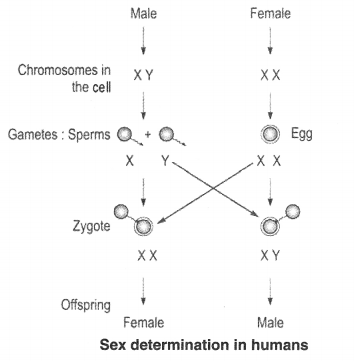
Page Number: 150
Question 1. What are the different ways in which individuals with a particular trait may increase in a population ? Answer: Different ways in which individuals with a particular trait may increase in a population are as follow :
- If it gives the benefit of survival through natural selection.
- Due to a sudden increase in a particular trait in a population, i.e., by genetic drift.
Question 2. Why are traits acquired during the life-time of an individual not inherited ? Answer: The traits acquired during the life-time are changes in the non-reproductive cells of the organisms and are not capable of being passed on to the next generation.
Question 3. Why are the small numbers of surviving tigers a cause of worry from the point of view of genetics ? Answer: The small numbers of surviving tigers are a cause of worry from the point of view of genetics because in tigers there are negligible genetic variations. Due to this they are not well adapted. The rapid environmental changes cannot be favouable for them. If these changes are not controlled, tigers would be wiped out.
Page Number: 151
Question 1. What factors would lead to the rise of a new species ? Answer: The factors that would lead to the rise of a new species are the following :
- Geographical isolation of a population caused by various types of barriers (such as mountain ranges, rivers and sea). The geographical isolation leads to reproductive isolation due to which there is no flow of genes between separated groups of pupulation.
- Genetic drift caused by drastic changes in the frequencies of particular genes by chance alone.
- Variations caused in individuals due to a natural selection.
Question 2. Will geographical isolation be a major factor in the speciation of a self- pollinating plant species ? Why or why not ? Answer: The geographical isolation cannot be major factor in the speciation of a self-pollinating plant species because it does not have to look the plants for its process of reproduction to be carried out.
Question 3. Will geographical isolation be a major factor in the speciation of an organism that reproduces asexually ? Why or why not ? Answer: Geographical isolation cannot be a major factor in the speciation of an asexually reproducing organism because it does not require any other organism to carry out reproduction.
Page Number: 156
Question 1. Give an example of characteristics being used to determine how close two species are in evolutionary terms. Answer: If similar characteristics are shown in different organisms, then these are considered to be inherited from the common ancestry. It also shows the closeness of the species. For example, bats and birds have some similarity in their wings, so they are closely related, while lizard and squirrel do not have wings so these are not closely related to the birds and bats.
Question 2. Can the wing of a butterfly and the wing of a bat be considered homologous organs ? Why or why not ? Answer: The wings of a butterfly and the wings of a bat cannot be considered to be homologous organs because they have different basic designs though they are used for the same purpose of flying. They are analogous organs.
Question 3. What are fossils ? What do they tell us about the process of evolution ? Answer: Fossils : Fossils are the remains or traces of a dead organism. These are formed through the formation of sedimentary rocks. They provide following information on the process of evolution.
- They tell about the changes that occured on the earth’s surface and the corresponding organisms.
- They tell about the gradual development of complex structured organisms from simple structured organisms.
- It is known through them that birds are evolved from reptiles.
- They state that angiosperms are developed from pteriodophytes and gymnosperms.
- They exhibit the process of humana evolution.
Page Number: 158
Question 1. Why are human beings who look so different from each other in terms of size, colour and looks said to belong to the same species ? Answer: This is because although genetic make up of humans may be slightly different in different races of people, there is no reproductive isolation. Reproductive isolation differentiates one species from the other. Human beings different in size, colour and looks can marry among themselves and produce fertile offspring.
Question 2. In evolutionary terms, can we say which among bacteria, spiders, fish and chimpanzees have a ‘better’ body design ? Why or why not ? Answer: Bacteria is a primitive organism as they came into being very early in evolution. But these organisms are still surviving in the present conditions after millions of years. This is because they have adapted well to the changing environment over these years. Same is the case for all other organisms like spiders, fishes and chimpanzees which have adapted to their environment and have survived. Therefore, all the organisms which exist have a body design which is better as it is suited to their environment.
NCERT Solutions for Class 10 Science Chapter 9 Textbook Chapter End Questions
Question 1. A Mendelian experiment consisted of breeding tall pea plants bearing violet flowers with short pea plants bearing white flowers. The progeny all bore violet flowers, but almost half of them were short. This suggests that the genetic make-up of the tall parent can be depicted as: (a) TTWW (b) TTww (c) TtWW (d) TtWw Answer: (c) TtWW
Question 2. An example of homologous organs is : (a) our arm and a dog’s fore-leg (b) our teeth and an elephant’s tusks (c) potato and runners of grass (d) all of the above Answer: (d) All of the above
Question 3. In evolutionary terms, we have more in common with : (a) a Chinese school-boy (b) a chimpanzee (c) a spider (d) a bacterium Answer: (a) A Chinese school-boy
Question 4. A study found that children with light coloured eyes are likely to have parents with light coloured eyes. On this basis, can we say anything about whether the light eye colour trait is dominant or recessive ? Why or why not ? Answer: This information is not complete. On the basis of this, it cannot be decided light colour trait is dominant or recessive. So it cannot be said until one does not know the nature of this trait in the parents.
Question 5. How are the areas of study-evolution and classification interlinked ? OR ‘Two areas of study namely ‘evolution’ and ‘classification’ are interlinked”. Justify this statement. [AICBSE 2016] Answer: Classification of organisms is based on relative similarities and differences among organisms. Resemblances in organisms are because they have arisen from a common ancestor and differences in them are due to adaptations to different types of environment. Since the organisms can be graded in order of increasing complexity it indicates at the concept of evolution.
Question 6. Explain the terms analogous and homologous organs with examples. [CBSE 2011,2013, 2014] Answer: Analogous organs : Those organs which have different basic structure (or different basic design) but have similar appearance and perform similar functions are called analogous organs. For example, The wings of an insect and a bird are analogous organs.
Homologous organs : Those organs which have the same basic structure (or same basic design) but different functions are called homologous organs. For example, The wing of a bat, flipper of a seal, front leg of a horse and arm of a man are homologous organs.
Question 7. Outline a project which aims to find the dominant coat colour in dogs. Answer: Suppose a black homozygous male is mated with a white homozygous female. If the progeny has all black dogs then the dominant coat colour is black.
Question 8. Explain the importance of fossils in deciding evolutionary relationships. Answer: Fossils play important role in providing evolutionary evidences because by knowning the age of fossils we can know about the evolution process of an organism. For example, a fossil bird called archaeopteryx that looked like a bird had many other features of reptiles. It had feathered wings like those of birds, but teeth and tail like those of reptiles. Archaeopteryx is, therefore, a connecting link between the reptiles and birds, and hence suggests that the birds have evolved from the reptiles.
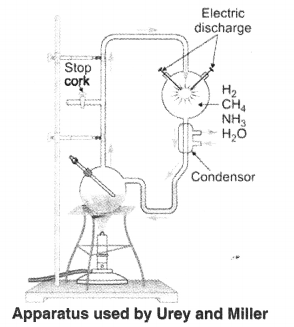
Question 10. Explain how sexual reproduction gives rise to more viable variations than asexual reproduction. How does this affect the evolution of those organisms that reproduce sexually ? [CBSE 2011,2014] Answer: During sexual reproduction there is ‘crossing over’ of chromosomes, that gives rise to variations. These variations are inherited and increase the chances of survival of an organism.
- In sexual reproduction variations may occur due to errors in DNA copying.
- There may be variations due to interchange of homologous chromosomes during crossing over of male and female.
- In sexual reproduction, it is not predetermined that which gamete would fuse with another gamete. It depends only on chance. It is also a reason of variation. These variations enable the organisms to adapt themselves to the changing conditions and also help to give rise to new species.
Question 11. How is the equal genetic contribution of male and female parents ensured in the progeny ? [CBSE 2011, 2013] Answer: Genetic material in most organisms is present in pairs of chromosomes. Gametes in the sexually reproducing organisms are formed by the process of meiosis during which half of the genetic material goes into each gamete. When the gametes from male and female parents fuse with each other during sexual reproduction, the normal complement is restored. Half of the genetic material comes from the female and half from the male.
Question 12. Only variations that confer an advantage to an individual organism will survive in a population. Do you agree with this statement ? Why or why not? Answer: Yes, variations that confer an advantage to an individual organism are inherited. The organism can survive longer in an environment and maintain its existence in the population.
Heredity and Evolution: Heredity; Mendel’s contribution- Laws for inheritance of traits, Sex determination : brief introduction; Basic concepts of evolution.
| CBSE | |
| NCERT | |
| Class 10 | |
| Science | |
| Chapter 9 | |
| Heredity and Evolution | |
| 29 | |
Formulae Handbook for Class 10 Maths and Science
Question 1. If a trait A exists in 10% of a population of an asexually reproducing species and a trait B exists in 60% Of the same population, which trait is likely to have arisen earlier ? Answer: As species are asexually reproducing, there would be only very minor differences generated due to small inaccuracies in DNA copying, so trait B, which exists in 60% of the same population may get inherited earlier while trait A, which exists in 10% of the population may be originated late due to variations. Thus, trait B have arisen earlier since it is present in 60% of the same population.
Question 2. How does the creation of variations in a species promote survival ? Answer: Natural selection selects the individuals having useful variations which ensure their survival in the prevailing conditions of environment. Variant individuals that can withstand or cope with prevailing environment will survive better and will increase in number through differential reproduction.
More Resources for CBSE Class 10
NCERT Solutions
- NCERT Solutions for Class 10 Science
- NCERT Solutions for Class 10 Maths
- NCERT Solutions for Class 10 Social
- NCERT Solutions for Class 10 English
- NCERT Solutions for Class 10 Hindi
- NCERT Solutions for Class 10 Sanskrit
- NCERT Solutions for Class 10 Foundation of IT
- RD Sharma Class 10 Solutions
Question 1. How do Mendel’s experiments show that traits may be dominant or recessive ? Answer: Mendel took pea plants with contrasting characteristics – tall plant and dwarf (short) plant. On cross pollination, he got all tall plants in F1 generation. Then by self pollination of F1 tall plants, he produced second generation (F2) consisting of tall and short plants in the ratio of 3 : 1. Then he concluded that, ‘T’ (tall) trait is dominant while ‘t’ trait for shortness is recessive.
Download NCERT Solutions for Class 10 Science Chapter 9 Heredity and Evolution PDF
Question 2. How do Mendel’s experiments show that traits are inherited independently ? Answer: In a dihybrid cross made by Mendel, it was observed that when two pairs of traits or characters were considered; each trait expressed independent of the other. Thus, Mendel was able to propose the Law of Independent Assortment which says about independent inheritance of traits.
Question 3. A man with blood group A marries a woman with blood O and their daughter has blood group O. Is this information enough to tell you which of the traits – blood group A or O is dominant ? Why or why not ?
Answer: No. This information is not sufficient to determine which of the traits − blood group A or O − is dominant. This is because we do not know about the blood group of all the progeny.Blood group A can be genotypically AA or AO. Hence, the information is incomplete to draw any such conclusion.
Question 1. What are the different ways in which individuals with a particular trait may increase in a population ? Answer: Different ways are : variation, natural selection and genetic drift (isolation).
Question 2. Why are traits acquired during the lifetime of an individual not inherited ? Answer: Because acquired characters bring changes only in non-reproductive tissues and cannot change the genes of the germ cells. Thus, acquired traits cannot be passed to next generation.
Question 3. Why are the small numbers of surviving tigers a cause of worry from the point of view of genetics ? Answer: (i) If any natural calamity occurs and kills these small number of surviving tigers, they can become extinct resulting in the loss of some genes forever. (ii) Small number will lead to little recombination and, therefore, lesser variations. These both are very important for giving better survival chances to the species. (iii) Less number of species means lesser extent of diversity and lesser number Of traits which reduces the chances of adaptability with respect to the change in the environment.
Question 1. What factors could lead to the rise of a new species ? Answer: Genetic variations, natural selection and reproductive isolation could lead to the rise of a new species.
Question 2. Will geographical isolation be a major factor in the speciation of a self-pollinating plant species ? Why or why not ? Answer: No, because pollination occurs on the same plant in self-pollinating plant species.
Question 3. Will geographical isolation be a major factor in the speciation of an organism that reproduces asexually ? Why or why not ? Answer: No, because asexual reproduction involves single parent or organism.
Question 1. Give an example of characteristics being used to determine how close two species am in evolutionary terms ? Answer: Homologous organs, analogous organs and vestigial organs help to identify evolutionary relationships amongst the species.
Question 2. Can the wing of butterfly and the wing of a bat be considered homologous organs ? Why or why not ? Answer: No, wing of a bat and wing of a bird cannot be considered as homologous organs because they have different basic structure.
Question 3. What are fossils ? What do they tell us about the process of evolution ? Answer: Fossils are the impression or remains of ancient life found preserved in the sedimentary rocks. Fossils are direct evidences of evolution. Fossils also help to identify evolutionary relationship between apparently different species. They also tell about the extent of evolution that has taken place.
Page 158 Question 1. Why are human beings who look so different from each other in terms of size, colour and looks said to belong to the same species ? Answer: They look different because of interaction of genes with environment which results in change in their appearance. But they belong to the same species as they have same number of chromosomes and can breed among themselves.
Question 2. In evolutionary terms, can we say which among bacteria, spiders, fish and chimpanzees have a ‘better body design’ why or why not ? Answer: No, because different designs are the product of evolution and different species have different body design to suit or adapt to their environment.
Question 1. A Mendelian experiment consisted of breeding tall pea plants bearing violet flowers with short pea plants bearing whfte flowers. The progeny all bore violet flowers, but almost half of them are short. This suggests that the genetic make-up of the tall parent can be depicted as (a) TTWW (b) TTww (c) TtWW (d) TtWw Answer: (c) Genetic make-up of tall plant can be depicted by TtWW.
Question 2. An example of homologous organs is (a) our arm and a dogs fore-leg. (b) our teeth and an elephants tusks. (c) potato and runners of grass. (d) All of the above. Answer: (d) Both organs in all options have same basic structural design but have different functions and appearance.
Question 3. In evolutionary terms, we have more in common with (a) a Chinese school-boy. (b) a chimpanzee. (c) a spider. (d) a bacterium. Answer: (a) A Chinese school-bpy is also a human being.
Question 4. A study found that children with light-coloured eyes are likely to have parents with light-coloured eyes. On this basis, can we say anything about whether the light eye colour trait is dominant or recessive? Why or why not? Answer: We can say that light eye colour trait is dominant because only dominant traits are expressed in the first generation.
Question 5. How are the areas of study – evolution and classification— inteilinked? Answer: Evolution and classification are interlinked with each other in many ways. Classification is the most important term to explain evolution. It is based on the similarities and differences between two species or among two organisms. More closer the characteristics, the moe doser is the evolution and chances to be in the same group of classification. Thus, the classification of species is a reflection of their evolutionary relationship.
Question 6. Explain the terms analogous and homologous organs with examples. Answer: Analogous organs are those organs which have different basic structural designs and developmental origins but have similar appearance and perform similar functions. Examples: Wings of an insect and wings of a bat. Homologous organs are those organs which have the same basic structural design and developmenta’ origin but have different functions and appearance. Examples: Forelimbs of frog and forelimbs of human.
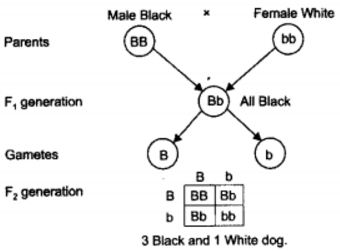
Question 8. Explain the importance of fossils in deciding evolutionary relationships. Answer: Fossils and their study is useful to know about the species which are no longer alive. They provide evidence and missing links between two classes. They are helpful in forming a sequence of organisms in the pathway of evolution. Thus, fossils have importance in deciding evolutionary relationships.
Question 9. What evidence do we have for the origin of life from inanimate matter? Answer: Stanley L. Miller and Harold C. Urey provided evidence regarding origin of life from inanimate matter. They assembled an atmosphere similar to that existed on early earth. The atmosphere had molecules like ammonia, methane, hydrogen sulphide and water, but no oxygen. The mixture was maintained at a temperature just below 100◦C and sparks were passed through the mixture of gases. At the end of a week, 15% carbon from methane had been converted to simple compounds of carbon like aminoacids which make up protein molecules. So, life arose afresh on earth.
Question 10. Explain how sexual reproduction gives rise to more viable variations that asexual reproduction. How does this affect the evolution of those organisms that reproduce sexually ? Answer: Variations occurring during sexual reproduction may be due to:
- Separation of homologous chromosomes (by chance only) during gamete formation.
- Crossing over (recombination) of homologous chromosomes.
- Fertilisation of gametes to form zygote.
- Errors during DNA copying or mutations.
In asexually reproducing organisms only errors during DNA copying or mutations cause variations. Since the extent of variations is much larger in sexually reproducing organisms, therefore, the chances of evolution is also much in sexually reproducing These variations enable the organisms to adapt themselves to the changing conditions and also help to face the struggle for Over the time, they and rise to new species.
Question 11. How is the equal genetic contribution of male and female parents ensured in the progeny? Answer: Genetically organisms are of types
(i) Haploid : They have single set of chromosomes, where each chromosome is represented singly. As the chromosomes are the bearer of genes so haploids have single set of genes. A single gene determines the expression of character. (ii) Diploid : ‘They have two sets Of homologous chromosomes, where the chromosome occur in pair, one maternal contributed by the mother through her ovum and the second Of the pair is contributed by the male parent through his sperm. The resultant cell zygote produces by the fusion of male and female gametes have two sets of chromosomes – each set contributed’ by each parent. In diploids a character is controlled by two genes/factors. Both the father and mother contribute practically equal amount of genetic material to the child. It means that each trait can be influenced by both paternal and maternal DNA.
Question 12. Only variations that confer an advantage to an individual organism will survive in a population. Do you agree with this statement ? Why or why not ? Answer: No, many of the times the variations are not advantageous to an individual organism but still survive in a population, e.g., take the case of free ear lobe and attached ear lobe. Most of the other variations not only give survival advantage to an individual but also contribute to genetic drift. Thus, we can say that most of the variations lead to better adaptation of an organism to the changing environment. In this way, it gives survival advantage to that organism and will also survive in the coming population.
Multiple Choice Questions (MCQs) [1 Mark each]
Question 1. An example of homologous organs is [NCERT] (a) our arm and a dog’s foreleg (b) our teeth and an elephant’s tusks (c) potato and runners of grass (d) All of the above Answer: (a) Our arm and a dog’s foreleg is the example of homologous organs.
Question 2. The science, which deals with study of heredity and variations is called (a) phylogeny (b) embryology (c) genetics (d) palaeontology Answer: (c) The genetics is the study of heredity and variations and includes their occurrence, causes, benefits, disadvantages, significance, etc.
Question 3. Archaeopteryx is a connecting link between (a) reptiles and aquatic animals (b) birds and insects (c) reptiles and birds (d) birds and dinosaurs Answer: (c) Archaeopteryx is a connecting link- between the reptiles and birds. It appears like a bird, but has other features which are present in reptiles, e.g. it has wings like bird, but teeth and tail like the reptilians.
Question 4. For palaeontological studies a scientist will gather the evidences from (a) study of homology (b) study of analogy (c) fossils (d) All of these Answer: (d) Study of homologous and analogous organs indicates the origin and modification in organisms and study of fossils indicates the age and features of an organism.
Question 5. In evolutionary terms, we have more in common with [NCERT] (a) a Chinese school boy (b) a chimpanzee (c) a spider (d) a bacterium Answer: (a) Chinese school boy because both of us belong to the same species, i.e. Homo sapiens.
Question 6. Aditya was observing some organisms in lab and tried to compare them. The presence of which organs will confirm to him that they share evolutionary history? (a) Analogous organs (b) Paralogous organs (c) Homologous organs (d) None of these Answer: (c) Homologous organs are present in organisms who share evolutionary history. However, these organs perform different functions in different organisms.
Question 7. New species may be formed if I. DNA undergoes significant changes in germ cells. . II. chromosome number changes in the gamete. III. there is no change in the genetic material. IV. mating does not take place. (a) I and II (b) I and III (c) II, III and IV (d) I, II and III Answer: (a) New species may be formed if the DNA changes are severe enough, such as a change in the number of chromosome. This leads to new variations.
Question 8. Which of the following statements is not true with respect to variation? (a) All variations in a species have equal chance of survival. (b) Change in genetic composition results in variation. (c) Selection of variants by environmental factors forms the basis of evolutionary processes. (d) Variation is minimum in asexual reproduction. Answer: (a) All variations in a species do not have equal chances of survival. Some of the variations may be so drastic that the new DNA copy cannot work with the cellular apparatus it inherits. Such, a newborn cell dies soon.
Question 9. Select the statement that describes characteristics of genes. . (a) Genes are specific sequence of bases in a DNA molecule. (b) A gene does not code for proteins. (c) In individuals of a given species, a specific gene is located on a particular chromosome. (d) Each chromosome has only one gene. Answer: (b) Genes are stretches of DNA found on chromosomes of a cell. A gene contains information for making proteins in a cell. A specific gene is located on a particular chromosome in individuals of a given species.
Question 10. If a round, green seeded pea plant (RRyy) is crossed with wrinkled, yellow seeded pea plant (rrYY), the seeds produced in F1 – generation will be [NCERT Exemplar] (a) round and yellow (b) round and green (c) wrinkled and green (d) wrinkled and yellow Answer: (a) The cross between RRyy and rrYY seeds will produce RrYy (round and yellow) seeds in F1-generation, because round and yellow are the dominant traits.
Question 11. From the list given below, select the character, which can be acquired but not inherited. [NCERT Exemplar] (a) colour of eye (b) colour of skin (c) size of body (d) nature of hair Answer: (c) Acquired traits develop in response to the environment. The size of the body is an acquired trait because it can vary based on the availability of less or more food. The other three colour of eye and skin and nature of hair are characters inherited from the parents.
Question 12. According to the evolutionary theory, formation of a new species is generally due to [NCERT Exemplar] (a) sudden creation by nature. (b) accumulation of variations over several generations. (c) clones formed during asexual reproduction. (d) movement of individuals from one habitat to another Answer: (b) Accumulation of variations over several generations forms new species. Genetic drift accumulates different changes in sub-populations of a species. Also, natural selection may also operate differendy in the different geographic locations. Eventually, different groups of new species will be formed.
Question 13. Select the incorrect statement. [NCERT Exemplar] (a) Frequency of certain genes in a population changes over several generations resulting in evolution. (b) Reduction in weight of the organism due to starvation is genetically controlled. (c) Low weight parents can have heavy weight progeny. (d) Traits which are not inherited over generations do not cause evolution. Answer: (b) The weight reduction due to starvation will not change the DNA of the germ cells, because low weight is not a trait that is genetically controlled or inherited. Also, low weight parents may have heavy weight progeny.
Question 14. In human males all the chromosomes are paired perfectly except one. This/these unpaired chromosome is/are I. large chromosome II. small chromosome III. Y-chromosome IV X-chromosome (a) I and II (b) Only III (c) III and IV (d) II and IV Answer: (c) In human males, one pair called the sex chromosomes are unpaired. Here, one is a normal-sized X-chromosome while other is a short Y-chromosome. Women have a perfect pair of sex chromosomes, both called X.
Question 15. Rajneesh was studying the fossils of two different types, fossil A was found in upper layer of Earth and B in deeper layers. What can be predicted regarding the age of these fossils? (a) A has recently become extinct (b) B has become extinct recently (c) The time of extinction cannot be determined (d) None of the above Answer: (a) Since, fossil A was found in upper layer of earth, it suggests that the organism has become extinct recently. Fossil B found in deeper layer must have become extinct long time ago and deposition of other layers occurred over it during this period.
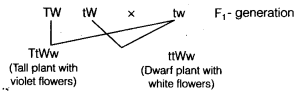
NCERT Solutions for Class 10 Science Chapter 9 Heredity and Evolution (Hindi Medium)
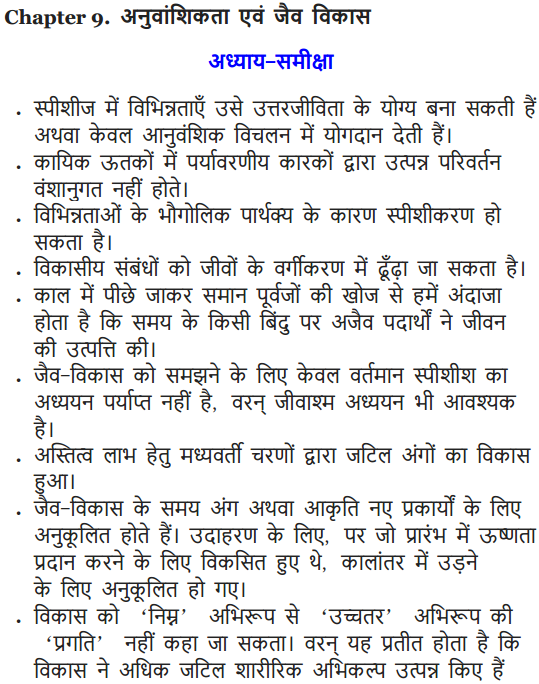
Class 10 Science Heredity and Evolution Mind Map
- Characters or features or traits are inherited from one generation to the next during reproduction.
- This inheritance provides both a common basic body design & subtle changes in it for next generation.
- When this generation reproduces, the offspring would have differences they inherit from previous generation as well as newly created differences.
- Accumulation of these differences generation after generation leads to the development of variations in a population.
- Different variations provide different advantages to the population and the variation which provide best survival advantages are inherited to the next generation.
- For e.g. bacteria having variation to tolerate heat will survive and multiply better in heat wave.
Heredity Heredity refers to the transmission of characteristics from parent to offspring by means of genes in the chromosomes. Mendel’s Contributions
- Mendel was the first scientist whose studies lead to the formulation of laws of inheritance.
- He conducted cross hybridization experiments of garden pea plant (Pisum sativum) and studied the transmission of characters that had two contrasting traits such as round/wrinkled seeds, tall/short plants, white/’violet flowers etc.
Experiment 1: He cross pollinate pure breeds of tall (TT) & dwarf (tt) pea plant and calculated the percentages of tall & dwarf progeny. Observation: F 1 generation was tall (Tt) with no halfway characteristics. F 2 generation produced by self pollination of F 1 included tall and short plants in 3:1. (Genotypic ratio 1:2:1 for TT:Tt:tt) Inference: This indicates that both the tallness & shortness traits were inherited in the F, plants, but only the tallness trait was expressed. Thus, two copies of the trait are inherited in each sexually reproducing organism. These two may be identical (TT or tt) or may be different (Tt), depending on the parentage. Conclusion: This study leaded to the formulation of two laws: Law of dominance: states that only one character expresses itself in F, generation. Law of segregation: states that the two alleles of a character in an individual get separated or segregated during gamete formation and distributed randomly in gametes.
Experiment 2: He crossed the plant with two different characteristics such as tall plant with round seed and short plant with wrinkled seed. Other example may include round & green seeds (RRyy) and wrinkled & yellow seeds (rrYY). Observation: F 1 generation; all were tall & round i.e. tall & round are dominant. F 2 generation; tall plants with round seeds, tall with wrinkled seeds, short with round seeds, and short plants with wrinkled seeds in 9:3:3:1. Similarly, round & yellow, round & green, wrinkled & yellow, and wrinkled & green in 9:3:3:1. Inference: The tall/short trait and the round seed/wrinkled seed trait are independently inherited. Conclusion: It formulated the law of independent assortment which states that genes of different characters located in different pairs of chromosomes are independent of one another in their segregation during gamete formation.
Sex Determination Different species use different strategies for this:
- Environment: for e.g. the temperature at which fertilised eggs are kept determines the sex of developing animals in the eggs. It is observed in animals like crocodile, turtle etc.
- Snails can change sex. indicating that sex is not genetically determined.
- Humans have 22 autosomal & 1 sex chromosome pairs. Females have XX & males have XY. Hence, sex of a child is determined by what he/she has inherited (X or Y) from the father since, child will always inherit X from the mother. If X is inherited from father then child will be a girl & if Y is inherited then a child will be a boy.
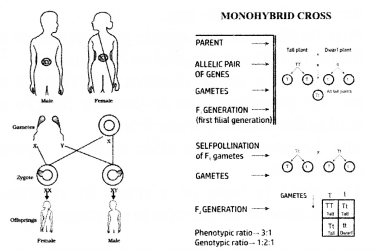
- It refers to gradual change in the characteristics of the population (plants & animals) over successive generations.
- Errors in DNA copying during reproduction, mutations, & natural selection account for the evolution.
- Evolution gives rise to such a biodiversity at each level of biological organization such as at species level, among individuals, molecules etc.
Evolution And Classification Classification is the process by which organisms are grouped into convenient categories based on some easily observable characters.
Characters such as cell type (prokaryote or eukaryote), single cell or multi cellular, presence or absence of nucleus, autotrophic (such as photosynthesis) or heterotrophic, sexual or asexual reproduction etc. are used to classify different organisms in different groups.
The more characteristics two species will have in common, the more closely they are related. And the more closely they are related, the more recently they will have had a common ancestor. For e.g. brother & sister are more closely related than a girl & her first cousin. Therefore, classification of species gives a reflection of their evolutionary relationship.
Tracing Evolutionary Relationships Few evidences which help us to trace evolutionary relationships among different organisms or species:
- Homologous: Similar structure different functions. It indicates common ancestry for e.g. bones of forelimbs in frog, lizard, bird & human.
- Analogous: Similar functions but different structure. Different structures evolved for same function & hence having similarity. For e.g. wings of bats & birds, eye of octopus & mammals, etc.
- The age of the fossils can be estimated by two ways; relative depth of the fossils, dating fossils i.e. detection of ratios of different isotopes of the same element in the fossil material
- It refers to a gradual evolutionary process by which populations evolve to become different species.
- Reproductive and geographical isolation play an important role in the process of speciation. They result in change in the frequency of an existing gene variant in a population i.e. genetic drift.
- Over generations, genetic drift along with natural selection results in the formation of new’ species,
- Other factors that may result in speciation are sudden severe DNA changes (mutation) such as change in chromosomal no., variation such as female green beetle will not mate with red males. Her behavior ensures the reproductive isolation between them and thus results in generation of new’ species.
Evolution Should Not Be Equated With ‘progress’
- Evolution is simply the generation of diversity & shaping of diversity by environmental selection.
- The only progressive trend in evolution seems to be the emergence of more and more complex body designs over time. However, that doesn’t mean that the older designs are inefficient.
- For e.g. simplest life forms; bacteria inhabits the most inhospitable habitats like hot springs, deep-sea thermal vents & ice in Antarctica.
- Tolls, like excavating, time-dating and studying fossils, determining DNA sequences etc, have been used for studying human evolution.
- All humans are a single species regardless of skin color or human races.
- The earliest members of the human species, Homo sapiens, can be traced back to Africa i.e. we all come from Africa.
- A couple of hundred thousand years ago, some of our ancestors left Africa while others stayed on.
- The migrants slowly spread across the planet; from Africa to West Asia, then to Central Asia, Eurasia, South Asia, & East Asia.
- They travelled down the islands of Indonesia and the Philippines to Australia, and they crossed the Bering land bridge to the Americas.
We hope this detailed article on NCERT Solutions For Class 10 Science Chapter 9 Heredity and Evolution is helpful. If you have any query regarding this article or NCERT Solutions For Class 10 Science Chapter 9 Heredity and Evolution, leave your comments in the comment section below and we will get back to you as soon as possible.
NCERT Solutions for Class 10 Science All Chapters
- Chapter 1 Chemical Reactions and Equations
- Chapter 2 Acids, Bases and Salts
- Chapter 3 Metals and Non-metals
- Chapter 4 Carbon and Its Compounds
- Chapter 5 Periodic Classification of Elements
- Chapter 6 Life Processes
- Chapter 7 Control and Coordination
- Chapter 8 How do Organisms Reproduce?
- Chapter 9 Heredity and Evolution
- Chapter 10 Light Reflection and Refraction
- Chapter 11 Human Eye and Colourful World
- Chapter 12 Electricity
- Chapter 13 Magnetic Effects of Electric Current
- Chapter 14 Sources of Energy
- Chapter 15 Our Environment
- Chapter 16 Management of Natural Resources
Free Resources
Quick Resources
NCERT Solutions for class-10 Science chapter-9 Heredity and Evolution
- Active page
NCERT Solutions for class-10 Science Chapter 9 Heredity and Evolution is prepared by senior and renown teachers of Physics Wallah primary focus while solving science questions of class-10 is NCERT textbook, Read the theory of this chapter and try to understand the meaning and then after start writing the questions given in class-10 NCERT textbook for the chapter 9. NCERT Solutions are accessible in PDF format on Physics Wallah.com. Here all chapter lists with detailed examples for NCERT Solution for Class 10 Science.
Answer The Following Question.

Checkout Class 10th Books from PW Store
2. How does the creation of variations in a species promote survival? Solution : Depending on the nature of variations different individuals would have difference kinds of advantage to adjust in particular habitat. Variation help the individual to have different traits that may develop the organisms more tolerable.
Checkout Class 10th Combos from PW Store
3. How do Mendel’s experiments show that traits may be dominant or recessive? Solution : In Monohybrid cross of Mendel between tall and dwarf pea plant, all progeny in F1 generation are tall and in F2 generation, 75% of pea plants are tall but 25% are dwarf. This shows that traits are dominant or recessive.
Checkout Class 10th Modules from PW Store
4. How do Mendel’s experiments show that traits are inherited independently? Solution : When a pea plant having round green seeds is crossed with a pea plant having wrinkled yellow seeds in F1 generation all the plants have round yellow seeds. But in F2 generation two new traits that is round yellow and wrinkled green appear. This shows that traits are inherited independently.
Checkout Class 10th Sample Papers from PW Store
5. A man with blood group A marries a woman with blood group O and their daughter has blood group O. Is this information enough to tell you which of the traits-blood group A or O- is dominant? Why or why not? Solution : No, the information is not enough because the blood group is determined by a pair of gene. One inherited from mother and other from father. In this case, the child inherited gene for O blood group from mother as well as father.
6. How is the sex of the child determined in human beings? Solution : A child which inherits X chromosome from her father will be a girl and one who inherits Y chromosome from him will be a boy.
Checkout Class 10th Previous Year Papers from PW Store
7. What are the different ways in which individuals with a particular trait may increase in a population? Solution : The different ways in which individual with a particular trait may increase are:
(a) Natural selection- Certain variations give survival advantage to individuals in a population in a changed situation resulting in increase of their population.
(b) Genetic drift- Accidents in small population even if they give no survival advantage also lead to increase to certain individual in population.
8. Why are traits acquired during the life-time of an individual not inherited?
Solution : Any change in nor-reproductive tissues cannot be passed on to the DNA of the germ cells. Therefore, the traits acquired during life-time on an individual are not inherited.
Checkout Class 10th Question Bank from PW Store
9. Why are the small numbers of surviving tigers a cause of worry from the point of view of genetics?
Solution : It will affect the frequency of selection which is essential for survival. For effective selection, the population must consist of an infinitely large number of individual in population.
10. What factors could lead to the rise of a new species?
Following factors could lead to the rise of new species:
(a) Changes in gene frequency in small breeding isolated populations.
(b) Natural selection
(c) Changes in number of chromosome.
11. Will geographical isolation be a major factor in the speciation of self-pollinating plant species? Why or why not?
Solution : No, because geographical barrier do not allow breeding between such individuals of a population which reproduce sexually. Moreover, asexually reproducing organism pass on the parental DNA to offspring which gives no chance of speciation.
12. Will geographical isolation be a major factor in the speciation of an organism that reproduces asexually? Why or why not?
Solution : Yes, due to geographical isolation, the two populations are separated. The levels of gene flow between them will decrease. The isolated population will breed with local population resulting in entry of isolated population into new population.
13. Give an example of characteristics being used to determine how close two species are in evolutionary terms.
Solution : Analysis of the organ structure in fossils allows us to make estimates of how far evolutionary relationships go. For example, presence of feather in some fossils dinosaurs indicate the birds are closely related to reptiles.
14. Can the wing of a butterfly and the wing of the bat be considered homologous organs?
Solution : No, though the function of wing in both the cases in same but their structural plan and origin in different.
15. What are fossils? What do they tell us about the process of evolution?
Solution : Preserved traces if living organisms are called fossils found closer to the surface of earth are more recent in origin than the fossils we find in deeper layers. Fossils also help us to find evolutionary relation between organisms.
16. Why are human beings who look so different from each other in terms of size, colour and looks said to belong to the same species?
Solution : All humans are a single species Homo sapiens which originated in Africa. Some of our ancestors left Africa, while others stayed on. Those who migrated slowly spread across the planets.
17. In evolutionary terms, can we say which among bacteria, spiders, fish and chimpanzees have a ‘better’ body design? Why or why not?
Solution : Bacteria have better body design because it has so much variation to adjust in different climatic condition.
18. A Mendelian experiment consisted of breeding tall pea plants bearing violet flowers with short pea plants bearing white flowers. The progeny all bore violet flowers but almost half of them were short. This suggests that the genetic make-up of the tall parent can be depicted as
Solution : (c) TtWW
19. An example of homologous organs is
(a) Our arm and a dog’s fore-leg.
(b) Our teeth and an elephant’s tusks.
(c) Potato and runners of grass.
(d) All of the above.
Solution : (d) all of the above
20. In evolutionary terms, we have more in common with
(a) A Chinese school-boy.
(b) A chimpanzee
(c) A spider
(d) A bacterium
Solution : (a) a Chinese school boy.
21. A study found that children with light-coloured eyes are likely to have parents with light-coloured eyes. On this basis, can we say anything about whether the light eye colour trait is dominant or recessive? Why or why not?
Solution : No, since two copies of traits are inherited from parents, one from mother and the other form father. Unless we know the nature of these two variants of traits we cannot tell which is dominant and which is recessive. Recessive traits appear when both the parents contribute recessive allele. From this statement we can only presume are that both parents are contributing recessive allele.
22. How are the areas of study- evolution and classification interlinked?
Solution : When we classify organism we look for similarities among organism which allows us to group them. Based on these principles we can work out the evolutionary relationship to the species.
23. Explain the terms analogous and homologous organs with examples.
Solution : Analogous organs: Such organs which perform similar function but are different in structure and origin. Example- Wings of birds and wings of insects. Homologous organs: Such organs which may have different functions but similar structure and origin. Example- fore arm of frog, lizard and bird.
24. Outline a project which aims to find the dominant coat colour in dogs.
Dogs have a variety of genes that govern coat colour. There are at least eleven identified gene series (A, B, C, D, E, F, G, M, P, S, T) that influence coat colour in dog.
A dog inherits one gene from each of its parents. The dominant gene gets expressed in the phenotype. For example, in the B series, a dog can be genetically black or brown.
Let us assume that one parent is homozygous black (BB), while the other parent is homozygous brown (bb)

In this case, all the offsprings will be heterozygous (Bb).
Since black (B) is dominant, all the offsprings will be black. However, they will have both B and b alleles.
If such heterozygous pups are crossed, they will produce 25% homozygous black (BB), 50% heterozygous black (Bb), and 25% homozygous brown (bb) offsprings.

25. Explain the importance of fossils in deciding evolutionary relationship.
Solution : Fossils are the remains of the organism that once existed on earth. They represent the ancestors of the plants and animals that are alive today. They provide evidences of evolution by revealing the characteristics of the past organisms and the changes that have occurred in these organisms to give rise to the present organisms. Let us explain the importance of fossils in deciding evolutionary history with the help of the following example. Around 100 million years ago, some invertebrates died and were buried in the soil in that area. More sediment accumulated on top of it turning it into sedimentary rock. At the same place, millions of years later, some dinosaurs died and their bodies were buried on top of the sedimentary rock. The mud containing dinosaurs also turned into a rock. Then, millions of years later, some horse-like creatures died in that area and got fossilized in rocks above the dinosaur fossils. Some time later, due to soil erosion or floods in that area, the rocks containing horse like fossils are exposed. If that area is excavated deeper, then the dinosaur and invertebrates fossils can also be found. Thus, by digging that area, scientists can easily predict that horse-like animals evolved later than the dinosaurs and the invertebrates. Thus, the above example suggests that the fossils found closer to the surface of the earth are more recent ones than the fossils deeper layers.
26. What evidence do we have for the origin of life from inanimate matter?
Solution : A British scientist, J.B.S. Haldane, suggested that life originated from simple inorganic molecules. He believed that when the earth was formed, it was a hot gaseous mass containing elements such as nitrogen, oxygen, carbon, hydrogen, etc. These elements combined to form molecules like water (H 2 0), carbon dioxide (C0 2 ), methane (CH 4 ), ammonia (NH 3 ), etc. After the formation of water, slowly the earth surface cooled and the inorganic molecules interacted with one another in water to form simple organic molecules such as sugars, fatty acids, amino acids, etc. The energy for these reactions was provided by solar radiations, lightning, volcanic eruptions, etc. This was proved by the experiment of Stanley L. Miller and Harold C. Urey in 1953. They took a mixture of water (H 2 0), methane (CH 4 ), ammonia (NH 3 ), and hydrogen gas (H 2 ) in a chamber and sparks were passed through this mixture using two electrodes. After one week, 15% of the carbon from methane was converted into amino acids, sugars, etc. These organic molecules are polymerized and assembled to form protein molecules that gave rise to life on earth.
27. Explain how sexual reproduction gives rise to more viable variations than asexual reproduction. How does this affect the evolution of those organisms that reproduce sexually?
Solution : Variations arise either because of errors in DNA copying or as a result of sexual reproduction. Due to sexual reproduction genetic variability increases in the population from one generation to another. This happens due to the fact that sexually reproducing organism inherits half the genes from each parent. These variations are very important for the process of evolution.
28. Only variations that confer an advantage to an individual organism will survive in a population. Do you agree with this statement? Why or why not?
Solution : No, depending on the nature of variations different individuals have been different kinds of advantages. However, when a drastic change occurs in environment only those organisms in the population will survive which have an advantageous variation in that population to survive in changed environment.
29. How is the equal genetic contribution of male and female parents ensured in the progeny?
Solution : Equal contribution of male and female parents is ensured in progeny during sexual reproduction. Each trait of progeny is determined by a pair of alleles and gametes of male and female contain one allele. Each allele pairs during fertilisation combine together to determine traits. Thus, the traits of progeny are determined by equal genes from male and female.
Chapter Wise NCERT Solutions of Class-10 Science
Chapter 1 Chemical Reaction and Equations
Chapter 2 Acids, Bases and Salts
Chapter 3 Metals and Non-metals
Chapter 4 Carbon and its Compounds
Chapter 5 Periodic Classifications of Elements
Chapter 6 Life Processes
Chapter 7 Control and Cordination
Chapter 8 How to Organisms Reproduce
Chapter 9 Heridity and Revolution
Chapter 10 Light Reflection and Refraction
Chapter 11 The Human Eye and Colourful World
Chapter 12 Electricity
Chapter 13 Magnetic Effects of Electric Current
Chapter 14 Sources of Energy
Chapter 15 Our Environment
Chapter 16 Management of Natural Resources
Aditional Resource Notes For Class-10
Notes on Physics for class-10 Science
Notes on chemistry for class-10 Science
Notes on Biology for class-10 Science
Notes on Mathematics for class-10
Related Chapters

Recent Concepts

Talk to Our counsellor

- Gravitation Class 9 Case Study Questions Science Chapter 9

Last Updated on August 13, 2024 by XAM CONTENT
Hello students, we are providing case study questions for class 9 science. Case study questions are the new question format that is introduced in CBSE board. The resources for case study questions are very less. So, to help students we have created chapterwise case study questions for class 9 science. In this article, you will find case study questions for cbse class 9 science chapter 9 Gravitation.
| Gravitation | |
| Case Study Questions | |
| Competency Based Questions | |
| CBSE | |
| 9 | |
| Science | |
| Theme | Moving Things, People and Ideas |
| Class 9 Studying Students | |
| Yes | |
| Mentioned | |
Table of Contents
Case Study Questions on Gravitation
Question 1:
Pallavi Mam was demonstrating an experiment in his class with the setup as shown in the figure below.
She took an eraser, sharpener, steel spoon, plastic ruler, pencil, compass and rubber band and asked the students to place them on the surface of the water. Students observed that a few objects float on the surface of water while a few sink in water.

Read the given passage carefully and give the answer of the following questions:
Q1. An object floats in a liquid if the buoyant force is: a. zero b. greater than its weight c. less than its weight d. equal to its weight
Difficulty Level: Easy
Q 2. An object sinks in a liquid if the buoyant force is: a. zero b. greater than its weight c. less than its weight d. equal to its weight
Q 3. The buoyant force on an object immersed in a liquid act: a. in the vertically upward direction b. in the vertically downward direction c. at an angle of 90 0 to the direction in which weight of the object acts. d. at an angle of 45 0 to the direction in which weight of the object acts.
Difficulty Level: Medium
Q 4. The magnitude of buoyant force depends on the: a. density of liquid b. volume of liquid c. weight of the object d. viscosity of liquid
Q 5. Magnitude of buoyant force is given by: a. Newton’s first law b. Archimedes’ principle c. Newton’s second law d. None of these
- (b) greater than its weight
- (c) less than its weight
- (a) in the vertically upward direction Explanation: The buoyant force on an object immersed in a liquid always acts vertically upwards, that is, in a direction opposite to the weight of the object.
- (a) density of liquid
- (b) Archimedes’ principle Explanation: Archimedes’ principle states that ‘when a body is immersed fully or partially in a fluid, it experiences an upward force (buoyant force) that is equal to the weight of the fluid displaced by it.’
Question 2:
What do aching feet, a falling apple and the orbit of the Moon have in common? Each is caused by the gravitational force. An apple falls from a tree because of the same force acting a few metres above Earth’s surface. And the Moon orbits Earth because gravity is able to supply the necessary centripetal force at a distance of hundreds of millions of metres. Sir Isaac Newton was the first scientist to precisely define the gravitational force, and to show that it could explain both falling bodies and astronomical motions.
The gravitational force is always attractive and it depends only on the masses involved and the distance between them (Newton’s universal law of gravitation).
Q 1. What is gravitational force?
Q 2. Briefly explain why Newton pondered over the existence of gravitation?
Q 3. Define the universal gravitational constant.
Q 4. State the value of G . Who obtained it for the first time?
Q 5. ‘Several phenomena of celestial bodies were believed to be unconnected but universal law of gravitation was successful to explain them.’ Mention any two phenomena.
- All objects (with mass) in the universe attract each other. This force of attraction between objects is called the gravitational force.
- It is said an apple fell on Newton’s head when he was sitting under a tree. He thought if Earth attracts an apple, can it also attract the Moon? Is the force same in both cases? This led to the study on gravitation.
- The universal gravitational constant is numerically equal to the force of attraction between two unit masses when they are separated by a unit distance as measured from their centres.
- The accepted value of G is 6.673 x 10 -11 N-m 2 kg -2 . The value of G was found out by Henry Cavendish by using a sensitive balance.
- Two phenomena explained by universal law of gravitation are: (i) the force that binds us to the Earth, and (ii) the motion of the Moon around the Earth.
Case study questions for other chapters of class 9 science is given below.
- Work and Energy Class 9 Case Study Questions Science Chapter 10
- Force and Laws of Motion Class 9 Case Study Questions Science Chapter 8
- Motion Class 9 Case Study Questions Science Chapter 7
- Tissues Class 9 Case Study Questions Science Chapter 6
- The Fundamental Unit of Life Class 9 Case Study Questions Science Chapter 5
Is Matter Around Us Pure Class 9 Case Study Questions Science Chapter 2
Matter in our surroundings class 9 case study questions science chapter 1.
We hope the given case study questions for Gravitation Class 9 helps you in your learning.
Helpful Links for CBSE Class 9 Science Preparation
- Chapter Tests for CBSE Class 9 Science
- Worksheets for CBSE Class 9 Science
- 100 Important Numerical Problems for CBSE Class 9 Physics
- 65 Important Case Study Questions for CBSE Class 9 Science
Topics from which case study questions may be asked
- Gravitation: Gravitation; Universal Law of Gravitation
- Force of Gravitation of the earth (gravity)
- Acceleration due to Gravity
- Mass and Weight
- Floatation: Thrust and Pressure.
- Archimedes’ Principle; Buoyancy.
Gravitational Force is the force of attraction between any two objects in the universe.
Gravity is the force with which the Earth pulls the objects towards its centre.
Universal Law of Gravitation was given by Isaac Newton and states that, ‘the force of attraction between any two objects in the universe is directly proportional to the product of their masses and inversely proportional to the square of distance between them’.
The direction of the gravitational force is along the line joining the centres of two object.
For further practice on case study questions related to Gravitation Class 9 Science, we recommend exploring the link given below.
| Gravitation | |
| CBSE Class 9 Students | |
| MCQs | |
| 45 | |
| Instant Solutions after Completion of Quiz | |
| C | |
| Free |
How to take quiz or test using the given link
It’s quite simple!
Step 1: Click on the given link. You will see the below screen.

Step 2: Fill in the necessary details. There is no need to register. Just fill your email and name and click on the button “Take Assessment”. The below screen will appear.
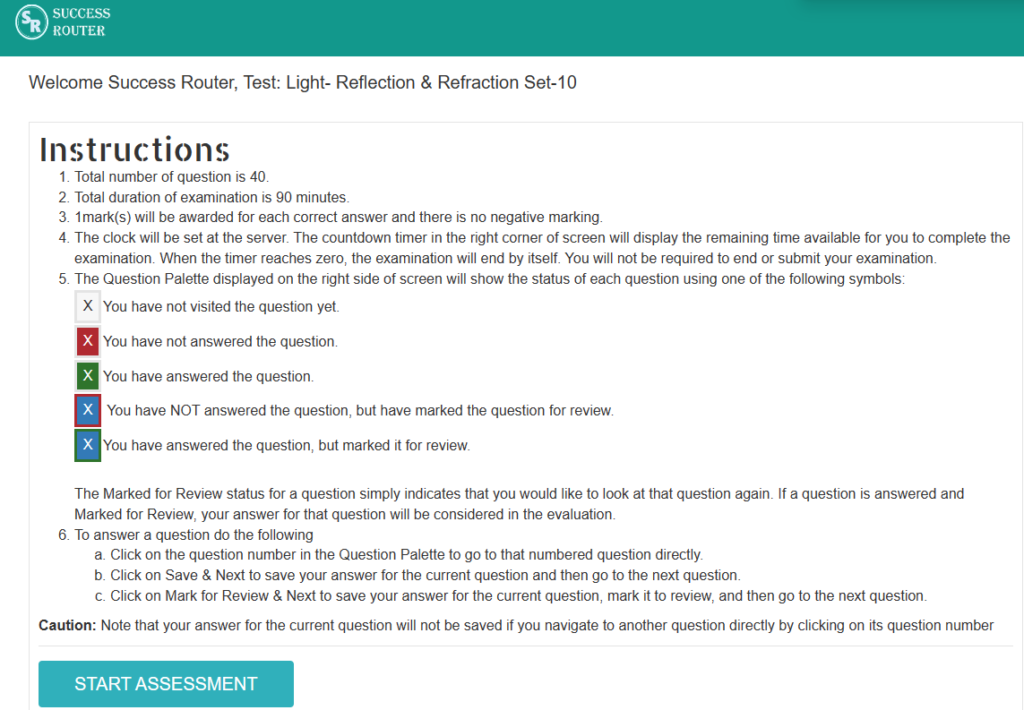
Step 3: Click on start assessment. Now you are ready to take test.
Frequently Asked Questions (FAQs) on Gravitation Case Study Questions
Q1: what are case study questions for cbse examinations.
A1: Case study questions in CBSE examinations typically involve scenarios or real-life examples, requiring students to apply their understanding of concepts to solve problems or analyze situations.
Q2: Why are case study questions important for understanding class 9 science chapters?
A2: Case study questions provide a practical context for students to apply theoretical knowledge to real-world situations, fostering deeper understanding and critical thinking skills.
Q3: How should students approach answering case study questions for CBSE?
A3: Students should carefully read the case study, identify the key issues or problems presented, analyze the information provided, apply relevant concepts and principles of chemical reactions and equations, and formulate well-supported solutions or responses.
Q4: Are there any resources available online for students to practice case study questions on class 9 science chapters for CBSE exams?
A4: Yes, several educational websites offer case study questions for CBSE students preparing for science examinations. We also offer a collection of case study questions for all classes and subject on our website. Visit our website to access these questions and enhance your learning experience. If you need more case study questions for your preparation, then you visit Physics Gurukul website.
Q5: How can students effectively prepare for case study questions on “Gravitation” for CBSE exams?
A5: Effective preparation strategies include regular revision of concepts, solving practice questions, analyzing case studies from previous exams, seeking clarification on doubts, and consulting with teachers or peers for guidance and support.
Q6: How can teachers incorporate case study questions on “Gravitation” class 9 science into classroom teaching?
A6: Teachers can integrate case studies into lesson plans, group discussions, or interactive activities to engage students in active learning, promote problem-solving skills, and facilitate a deeper understanding of “Force and Laws of Motion”.
Q7: When is the Importance of the Universal Law of Gravitation?
A7: The universal law of gravitation successfully explained several phenomena which are as follows: (i) the force that binds us to Earth, (ii) the motion of the Moon around the Earth, (iii) the motion of planets around the Sun, and (iv) the tides due to the Moon and the Sun.
Q8: What are the Applications of Archimedes’ Principle?
A8: It is used in: (i) designing ships and submarines. (ii) lactometers (used to determine the purity of a sample of milk). (iii) hydrometers (used for determining density of liquids).
Q9: If gravitational force acts between all objects, why don’t the two objects in a room move towards each other?
A9: The two objects in a room do not move towards each other because of their small masses, the gravitational force of attraction between them is very, very weak.
Q10: When a body is thrown upwards, its velocity becomes zero at the highest point. What will be its acceleration at this point?
A10: The acceleration at this point is equal to the value of g in the downward direction
Q11: How does the weight of a body vary from poles to equator?
A11: The weight of a body decreases from poles to equator because the force of gravitation is more at poles than at the equator.
Q12: What do you mean by buoyancy?
A12: The upward force exerted by a liquid on any object immersed in it is known as buoyant force or upthrust.
Download Customised White Label Study Materials in MS Word Format
We are providing teaching resources to teachers and coaching institute looking for customised study materials in MS word format. Our High-quality editable study material which is prepared by the expert faculties are Highly useful for Teachers, Mentors, Tutors, Faculties, Coaching Institutes, Coaching Experts, Tuition Centers.

Related Posts

myCBSEguide
- Class 9 Science Case...
Class 9 Science Case Study Questions
Table of Contents
myCBSEguide App
Download the app to get CBSE Sample Papers 2023-24, NCERT Solutions (Revised), Most Important Questions, Previous Year Question Bank, Mock Tests, and Detailed Notes.
If you are wondering how to solve class 9 science case study questions, then myCBSEguide is the best platform to choose. With the help of our well-trained and experienced faculty, we provide solved examples and detailed explanations for the recently added Class 9 Science case study questions.
You can find a wide range of solved case studies on myCBSEguide, covering various topics and concepts. Class 9 Science case studies are designed to help you understand the application of various concepts in real-life situations.
The rationale behind Science
Science is crucial for Class 9 students’ cognitive, emotional, and psychomotor development. It encourages curiosity, inventiveness, objectivity, and aesthetic sense.
In the upper primary stage, students should be given a variety of opportunities to engage with scientific processes such as observing, recording observations, drawing, tabulating, plotting graphs, and so on, whereas in the secondary stage, abstraction and quantitative reasoning should take a more prominent role in science teaching and learning. As a result, the concept of atoms and molecules as matter’s building units, as well as Newton’s law of gravitation, emerges.
Science is important because it allows Class 9 Science students to understand the world around us. It helps to find out how things work and to find solutions to problems at the Class 9 Science level. Science is also a source of enjoyment for many people. It can be a hobby, a career, or a source of intellectual stimulation.

Case study questions in Class 9 Science
The inclusion of case study questions in Class 9 science CBSE is a great way to engage students in critical thinking and problem-solving. By working through real-world scenarios, Class 9 Science students will be better prepared to tackle challenges they may face in their future studies and careers. Class 9 Science Case study questions also promote higher-order thinking skills, such as analysis and synthesis. In addition, case study questions can help to foster creativity and innovation in students. As per the recent pattern of the Class 9 Science examination, a few questions based on case studies/passages will be included in the CBSE Class 9 Science Paper. There will be a paragraph presented, followed by questions based on it.
Examples of Class 9 science class case study questions
Class 9 science case study questions have been prepared by myCBSEguide’s qualified teachers. Class 9 case study questions are meant to evaluate students’ knowledge and comprehension of the material. They are not intended to be difficult, but they will require you to think critically about the material. We hope you find Class 9 science case study questions beneficial and that they assist you in your exam preparation.
The following are a few examples of Class 9 science case study questions.
Class 9 science case study question 1
- due to its high compressibility
- large volumes of a gas can be compressed into a small cylinder
- transported easily
- all of these
- shape, volume
- volume, shape
- shape, size
- size, shape
- the presence of dissolved carbon dioxide in water
- the presence of dissolved oxygen in the water
- the presence of dissolved Nitrogen in the water
- liquid particles move freely
- liquid have greater space between each other
- both (a) and (b)
- none of these
- Only gases behave like fluids
- Gases and solids behave like fluids
- Gases and liquids behave like fluids
- Only liquids are fluids
Answer Key:
- (d) all of these
- (a) shape, volume
- (b) the presence of dissolved oxygen in the water
- (c) both (a) and (b)
- (c) Gases and liquids behave like fluids
Class 9 science case study question 2
- 12/32 times
- 18 g of O 2
- 18 g of CO 2
- 18 g of CH 4
- 1 g of CO 2
- 1 g of CH 4 CH 4
- 2 moles of H2O
- 20 moles of water
- 6.022 × 1023 molecules of water
- 1.2044 × 1025 molecules of water
- (I) and (IV)
- (II) and (III)
- (II) and (IV)
- Sulphate molecule
- Ozone molecule
- Phosphorus molecule
- Methane molecule
- (c) 8/3 times
- (d) 18g of CH 4
- (c) 1g of H 2
- (d) (II) and (IV)
- (c) phosphorus molecule
Class 9 science case study question 3
- collenchyma
- chlorenchyma
- It performs photosynthesis
- It helps the aquatic plant to float
- It provides mechanical support
- Sclerenchyma
- Collenchyma
- Epithelial tissue
- Parenchyma tissues have intercellular spaces.
- Collenchymatous tissues are irregularly thickened at corners.
- Apical and intercalary meristems are permanent tissues.
- Meristematic tissues, in its early stage, lack vacuoles, muscles
- (I) and (II)
- (III) and (I)
- Transpiration
- Provides mechanical support
- Provides strength to the plant parts
- None of these
- (a) Collenchyma
- (b) help aquatic plant to float
- (b) Sclerenchyma
- (d) Only (III)
- (c) provide strength to plant parts
Cracking Class 9 Science Case Study Questions
There is no one definitive answer to Class 9 Science case study questions. Every case study is unique and will necessitate a unique strategy. There are, nevertheless, certain general guidelines to follow while answering case study questions.
- To begin, double-check that you understand the Class 9 science case study questions. Make sure you understand what is being asked by reading it carefully. If you’re unclear, seek clarification from your teacher or tutor.
- It’s critical to read the Class 9 Science case study material thoroughly once you’ve grasped the question. This will provide you with a thorough understanding of the problem as well as the various potential solutions.
- Brainstorming potential solutions with classmates or other students might also be beneficial. This might provide you with multiple viewpoints on the situation and assist you in determining the best solution.
- Finally, make sure your answer is presented simply and concisely. Make sure you clarify your rationale and back up your claim with evidence.
A look at the Class 9 Science Syllabus
The CBSE class 9 science syllabus provides a strong foundation for students who want to pursue a career in science. The topics are chosen in such a way that they build on the concepts learned in the previous classes and provide a strong foundation for further studies in science. The table below lists the topics covered in the Class 9 Science syllabus of the Central Board of Secondary Education (CBSE). As can be seen, the Class 9 science syllabus is divided into three sections: Physics, Chemistry and Biology. Each section contains a number of topics that Class 9 science students must study during the course.
CBSE Class 9 Science (Code No. 086)
| I | Matter- Its Nature and Behaviour | 25 |
| II | Organization in the Living World | 22 |
| III | Motion, Force and Work | 27 |
| IV | Food; Food Production | 06 |
| 80 | ||
| 20 | ||
| 100 |
Theme: Materials Unit I: Matter-Nature and Behaviour Definition of matter; solid, liquid and gas; characteristics – shape, volume, density; change of state-melting (absorption of heat), freezing, evaporation (cooling by evaporation), condensation, sublimation. Nature of matter: Elements, compounds and mixtures. Heterogeneous and homogenous mixtures, colloids and suspensions. Particle nature and their basic units: Atoms and molecules, Law of constant proportions, Atomic and molecular masses. Mole concept: Relationship of mole to mass of the particles and numbers. Structure of atoms: Electrons, protons and neutrons, valency, the chemical formula of common compounds. Isotopes and Isobars.
Theme: The World of the Living Unit II: Organization in the Living World Cell – Basic Unit of life: Cell as a basic unit of life; prokaryotic and eukaryotic cells, multicellular organisms; cell membrane and cell wall, cell organelles and cell inclusions; chloroplast, mitochondria, vacuoles, endoplasmic reticulum, Golgi apparatus; nucleus, chromosomes – basic structure, number. Tissues, Organs, Organ System, Organism: Structure and functions of animal and plant tissues (only four types of tissues in animals; Meristematic and Permanent tissues in plants).
Theme: Moving Things, People and Ideas Unit III: Motion, Force and Work Motion: Distance and displacement, velocity; uniform and non-uniform motion along a straight line; acceleration, distance-time and velocity-time graphs for uniform motion and uniformly accelerated motion, derivation of equations of motion by graphical method; elementary idea of uniform circular motion. Force and Newton’s laws: Force and Motion, Newton’s Laws of Motion, Action and Reaction forces, Inertia of a body, Inertia and mass, Momentum, Force and Acceleration. Elementary idea of conservation of Momentum. Gravitation: Gravitation; Universal Law of Gravitation, Force of Gravitation of the earth (gravity), Acceleration due to Gravity; Mass and Weight; Free fall. Floatation: Thrust and Pressure. Archimedes’ Principle; Buoyancy. Work, energy and power: Work done by a Force, Energy, power; Kinetic and Potential energy; Law of conservation of energy. Sound: Nature of sound and its propagation in various media, speed of sound, range of hearing in humans; ultrasound; reflection of sound; echo.
Theme: Food Unit IV: Food Production Plant and animal breeding and selection for quality improvement and management; Use of fertilizers and manures; Protection from pests and diseases; Organic farming.
PRESCRIBED BOOKS:
- Science-Textbook for class IX-NCERT Publication
- Assessment of Practical Skills in Science-Class IX – CBSE Publication
- Laboratory Manual-Science-Class IX, NCERT Publication
- Exemplar Problems Class IX – NCERT Publication
myCBSEguide: A true helper
There are numerous advantages to using myCBSEguide to achieve the highest results in Class 9 Science.
- myCBSEguide offers high-quality study materials that cover all of the topics in the Class 9 Science curriculum.
- myCBSEguide provides practice questions and mock examinations to assist students in the best possible preparation for their exams.
- On our myCBSEguide app, you’ll find a variety of solved Class 9 Science case study questions covering a variety of topics and concepts. These case studies are intended to help you understand how certain principles are applied in real-world settings
- myCBSEguide is that the study material and practice problems are developed by a team of specialists who are always accessible to assist students with any questions they may have. As a result, students may be confident that they will receive the finest possible assistance and support when studying for their exams.
So, if you’re seeking the most effective strategy to study for your Class 9 Science examinations, myCBSEguide is the place to go!
Test Generator
Create question paper PDF and online tests with your own name & logo in minutes.
Question Bank, Mock Tests, Exam Papers, NCERT Solutions, Sample Papers, Notes
Related Posts
- Competency Based Learning in CBSE Schools
- Class 11 Physical Education Case Study Questions
- Class 11 Sociology Case Study Questions
- Class 12 Applied Mathematics Case Study Questions
- Class 11 Applied Mathematics Case Study Questions
- Class 11 Mathematics Case Study Questions
- Class 11 Biology Case Study Questions
- Class 12 Physical Education Case Study Questions
Leave a Comment
Save my name, email, and website in this browser for the next time I comment.
CBSE Expert

Case Study Questions of Class 9 Science PDF Download
Download PDF Case Study Questions of Class 9 Science to prepare for the upcoming CBSE Class 9 Exams Exam 2023-24. With the help of our well-trained and experienced faculty, we provide solved examples and detailed explanations for the recently added Class 9 Science case study questions .

Case study questions are based on real or hypothetical scenarios that require students to analyze, evaluate, and apply scientific concepts to solve problems or make informed decisions. They often present a detailed context, providing students with the opportunity to demonstrate their understanding of the subject matter beyond basic recall.
Table of Contents
Class 9 Science: Case Study Questions
The inclusion of case study questions in Class 9 science CBSE is a great way to engage students in critical thinking and problem-solving. By working through real-world scenarios, Class 9 Science students will be better prepared to tackle challenges they may face in their future studies and careers. Class 9 Science Case study questions also promote higher-order thinking skills, such as analysis and synthesis. In addition, case study questions can help to foster creativity and innovation in students. As per the recent pattern of the Class 9 Science examination, a few questions based on case studies/passages will be included in the CBSE Class 9 Science Paper. There will be a paragraph presented, followed by questions based on it.
Chapterwise Case Study Questions of Class 9 Science
- Case Study Questions for Chapter 1 Matter in Our Surroundings
- Case Study Questions for Chapter 2 Is Matter Around Us Pure?
- Case Study Questions for Chapter 3 Atoms and Molecules
- Case Study Questions for Chapter 4 Structure of Atom
- Case Study Questions for Chapter 5 The Fundamental Unit of Life
- Case Study Questions for Chapter 6 Tissues
- Case Study Questions for Chapter 7 Diversity in Living Organisms
- Case Study Questions for Chapter 8 Motion
- Case Study Questions for Chapter 9 Force and Laws of Motion
- Case Study Questions for Chapter 10 Gravitation
- Case Study Questions for Chapter 11 Work and Energy
- Case Study Questions for Chapter 12 Sound
- Case Study Questions for Chapter 13 Why do we Fall ill
- Case Study Questions for Chapter 14 Natural Resources
- Case Study Questions for Chapter 15 Improvement in Food Resources
You can find a wide range of solved case studies on cbseexperts, covering various topics and concepts. Class 9 Science case studies are designed to help you understand the application of various concepts in real-life situations.
Class 9 Science Syllabus
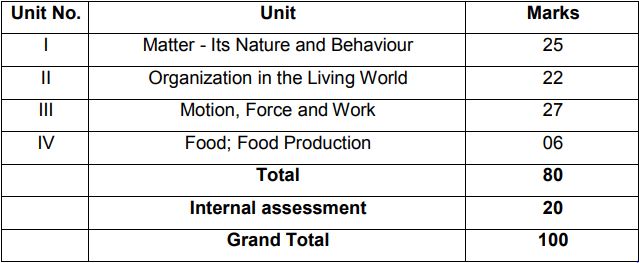
Unit I: Matter-Nature and Behaviour
Definition of matter; solid, liquid, and gas; characteristics – shape, volume, density; change of statementing (absorption of heat), freezing, evaporation (cooling by evaporation), condensation, sublimation.
Nature of matter: Elements, compounds, and mixtures. Heterogeneous and homogenous mixtures, colloids, and suspensions. Physical and chemical changes (excluding separating the components of a mixture).
Particle nature and their basic units: Atoms and molecules, Law of Chemical Combination, Chemical formula of common compounds, Atomic and molecular masses.
Structure of atoms: Electrons, protons and neutrons, Valency, Atomic Number and Mass Number, Isotopes and Isobars.
Unit II: Organization in the Living World
Cell – Basic Unit of life: Cell as a basic unit of life; prokaryotic and eukaryotic cells, multicellular organisms; cell membrane and cell wall, cell organelles and cell inclusions; chloroplast, mitochondria, vacuoles, endoplasmic reticulum, Golgi apparatus; nucleus, chromosomes – basic structure, number.
Tissues, Organs, Organ System, Organism: Structure and functions of animal and plant tissues (only four types of tissues in animals; Meristematic and Permanent tissues in plants).
Unit III: Motio n, Force, and Work
Motion: Distance and displacement, velocity; uniform and non-uniform motion along a straight line; acceleration, distance-time and velocity-time graphs for uniform motion and uniformly accelerated motion, elementary idea of uniform circular motion.
Force and Newton’s laws: Force and Motion, Newton’s Laws of Motion, Action and Reaction forces, Inertia of a body, Inertia and mass, Momentum, Force and Acceleration.
Gravitation: Gravitation; Universal Law of Gravitation, Force of Gravitation of the earth (gravity), Acceleration due to Gravity; Mass and Weight; Free fall. Floatation: Thrust and Pressure. Archimedes’ Principle; Buoyancy.
Work, Energy and Power: Work done by a Force, Energy, power; Kinetic and Potential energy; Law of conservation of energy (excluding commercial unit of Energy).
Sound: Nature of sound and its propagation in various media, speed of sound, range of hearing in humans; ultrasound; reflection of sound; echo.
Unit IV: Food Production
Plant and animal breeding and selection for quality improvement and management; Use of fertilizers and manures; Protection from pests and diseases; Organic farming.
Books for Class 9 Science Exams

Benefits of Case Study Questions
- Enhancing Analytical Skills : Case study questions challenge students to analyze complex scenarios, identify relevant information, and derive meaningful insights. By engaging with these questions, students develop critical analytical skills that are essential for scientific thinking and problem-solving.
- Promoting Critical Thinking : Case study questions encourage students to think critically and evaluate different perspectives. They require students to reason, make logical deductions, and justify their answers with supporting evidence. This process helps in honing their critical thinking abilities, enabling them to approach problems from multiple angles.
- Encouraging Practical Application of Concepts : By presenting real-world or hypothetical situations, case study questions promote the application of scientific concepts in practical scenarios. This application-based approach fosters a deeper understanding of the subject matter and helps students see the relevance of what they learn in the classroom to everyday life.
Case study questions of Class 9 Science provide students with an opportunity to apply their knowledge, enhance analytical skills, and think critically. By understanding the format, benefits, and effective strategies for answering case study questions, students can excel in this form of assessment. While challenges may arise, practicing time management, improving information extraction skills, and enhancing observation abilities will enable students to overcome these obstacles and perform well. Embracing case study questions as a valuable learning tool can contribute to a holistic understanding of scientific concepts and foster problem-solving abilities.
1. What is the purpose of case study questions in Class 9 Science?
Case study questions serve the purpose of evaluating a student’s understanding of scientific concepts, their ability to apply knowledge in real-life situations, and their analytical and critical thinking skills.
2. How can case study questions help improve analytical skills?
Case study questions require students to analyze complex scenarios, identify relevant information, and derive meaningful insights. Regular practice with such questions can significantly enhance analytical skills.
3. Are case study questions difficult to answer?
Case study questions can be challenging due to their comprehensive nature and the need for critical thinking. However, with practice and effective strategies, students can develop the skills necessary to answer them effectively.
Leave a Comment Cancel reply
Save my name, email, and website in this browser for the next time I comment.
Download India's best Exam Preparation App Now.
Key Features
- Revision Notes
- Important Questions
- Previous Years Questions
- Case-Based Questions
- Assertion and Reason Questions
No thanks, I’m not interested!

- Andhra Pradesh
- Chhattisgarh
- West Bengal
- Madhya Pradesh
- Maharashtra
- Jammu & Kashmir
- NCERT Books 2022-23
- NCERT Solutions
- NCERT Notes
- NCERT Exemplar Books
- NCERT Exemplar Solution
- States UT Book
- School Kits & Lab Manual
- NCERT Books 2021-22
- NCERT Books 2020-21
- NCERT Book 2019-2020
- NCERT Book 2015-2016
- RD Sharma Solution
- TS Grewal Solution
- TR Jain Solution
- Selina Solution
- Frank Solution
- Lakhmir Singh and Manjit Kaur Solution
- I.E.Irodov solutions
- ICSE - Goyal Brothers Park
- ICSE - Dorothy M. Noronhe
- Micheal Vaz Solution
- S.S. Krotov Solution
- Evergreen Science
- KC Sinha Solution
- ICSE - ISC Jayanti Sengupta, Oxford
- ICSE Focus on History
- ICSE GeoGraphy Voyage
- ICSE Hindi Solution
- ICSE Treasure Trove Solution
- Thomas & Finney Solution
- SL Loney Solution
- SB Mathur Solution
- P Bahadur Solution
- Narendra Awasthi Solution
- MS Chauhan Solution
- LA Sena Solution
- Integral Calculus Amit Agarwal Solution
- IA Maron Solution
- Hall & Knight Solution
- Errorless Solution
- Pradeep's KL Gogia Solution
- OP Tandon Solutions
- Sample Papers
- Previous Year Question Paper
- Important Question
- Value Based Questions
- CBSE Syllabus
- CBSE MCQs PDF
- Assertion & Reason
- New Revision Notes
- Revision Notes
- Question Bank
- Marks Wise Question
- Toppers Answer Sheets
- Exam Paper Aalysis
- Concept Map
- CBSE Text Book
- Additional Practice Questions
- Vocational Book
- CBSE - Concept
- KVS NCERT CBSE Worksheets
- Formula Class Wise
- Formula Chapter Wise
- JEE Previous Year Paper
- JEE Mock Test
- JEE Crash Course
- JEE Sample Papers
- Important Info
- SRM-JEEE Previous Year Paper
- SRM-JEEE Mock Test
- VITEEE Previous Year Paper
- VITEEE Mock Test
- BITSAT Previous Year Paper
- BITSAT Mock Test
- Manipal Previous Year Paper
- Manipal Engineering Mock Test
- AP EAMCET Previous Year Paper
- AP EAMCET Mock Test
- COMEDK Previous Year Paper
- COMEDK Mock Test
- GUJCET Previous Year Paper
- GUJCET Mock Test
- KCET Previous Year Paper
- KCET Mock Test
- KEAM Previous Year Paper
- KEAM Mock Test
- MHT CET Previous Year Paper
- MHT CET Mock Test
- TS EAMCET Previous Year Paper
- TS EAMCET Mock Test
- WBJEE Previous Year Paper
- WBJEE Mock Test
- AMU Previous Year Paper
- AMU Mock Test
- CUSAT Previous Year Paper
- CUSAT Mock Test
- AEEE Previous Year Paper
- AEEE Mock Test
- UPSEE Previous Year Paper
- UPSEE Mock Test
- CGPET Previous Year Paper
- Crash Course
- Previous Year Paper
- NCERT Based Short Notes
- NCERT Based Tests
- NEET Sample Paper
- Previous Year Papers
- Quantitative Aptitude
- Numerical Aptitude Data Interpretation
- General Knowledge
- Mathematics
- Agriculture
- Accountancy
- Business Studies
- Political science
- Enviromental Studies
- Mass Media Communication
- Teaching Aptitude
- Verbal Ability & Reading Comprehension
- Logical Reasoning & Data Interpretation
- CAT Mock Test
- CAT Important Question
- CAT Vocabulary
- CAT English Grammar
- MBA General Knowledge
- CAT Mind Map
- CAT Study Planner
- CMAT Mock Test
- SRCC GBO Mock Test
- SRCC GBO PYQs
- XAT Mock Test
- SNAP Mock Test
- IIFT Mock Test
- MAT Mock Test
- CUET PG Mock Test
- CUET PG PYQs
- MAH CET Mock Test
- MAH CET PYQs
- NAVODAYA VIDYALAYA
- SAINIK SCHOOL (AISSEE)
- Mechanical Engineering
- Electrical Engineering
- Electronics & Communication Engineering
- Civil Engineering
- Computer Science Engineering
- CBSE Board News
- Scholarship Olympiad
- School Admissions
- Entrance Exams
- All Board Updates
- Miscellaneous
- State Wise Books
- Engineering Exam

SHARING IS CARING If our Website helped you a little, then kindly spread our voice using Social Networks. Spread our word to your readers, friends, teachers, students & all those close ones who deserve to know what you know now.
CBSE Class 10th - SCIENCE : Chapterwise Case Study Question & Solution
In board exams, students will find the questions based on assertion and reasoning. Also, there will be a few questions based on case studies. In that, a paragraph will be given, and then the MCQ questions based on it will be asked. For Science subjects, there would be 5 case-based sub-parts questions, wherein a student has to attempt 4 sub-part questions.
| 1. Chemical Reactions & Equations | |
| 2. Acids, Bases & Salts | |
| 3. Metals & Non-metals | |
| 4. Carbon & Its Compounds | |
| 5. Periodic Classification of Elements | |
| 6. Life Processes | |
| 8. How Do Organisms Reproduce | |
| 9. Heredity & Evolution | |
| 10. Light-Reflection & Refraction | |
| 11. The Human Eye & the Colourful World | |
| 12. Electricity | |
| 13. Magnetic Effects of Electric Current | |
| 15. Our Environment |

- NCERT Solutions for Class 12 Maths
- NCERT Solutions for Class 10 Maths
- CBSE Syllabus 2023-24
- Social Media Channels
- Login Customize Your Notification Preferences
- CBSE Announces Online Marks Verification for Class 10 Supplementary Exams; Apply Online Beginning August 9 6 August, 2024, 10:45 am
- CBSE 10th Compartment Result 2024 Out: CBSE Class 10 Supplementary Results Released, Direct Link Here 5 August, 2024, 3:50 pm
- CBSE 10th Compartment Result 2024: CBSE to Release Class 10 Compartment Results Soon; Check Details Here 5 August, 2024, 3:28 pm
- When to Expect CBSE Class 10 Supplementary Results 2024? 3 August, 2024, 10:50 am
- CBSE 10th Exam 2024-25 : Mathematics (Volume-4) Official Competency Focused Practice Questions released by CBSE 1 August, 2024, 6:31 pm
- CBSE Class 10 Results 2024 : CBSE Class 10 Answer Book Photocopy Applications Open 4 June, 2024, 6:17 pm
- CBSE 10th 2024-25 : Social Science Official Competency Focused Practice Questions released by CBSE 28 May, 2024, 4:12 pm
- CBSE Class 10 Revaluation Application 2024 Process Begins : How to Apply, Fees, Direct Link & Step-by-Step Guide 21 May, 2024, 4:02 pm
- CBSE Class 10 Result 2024 Latest Update : Verification of Marks, Revaluation & Photocopy of Answer Sheet; Check Complete Process 14 May, 2024, 11:55 am

- Second click on the toggle icon

Provide prime members with unlimited access to all study materials in PDF format.
Allow prime members to attempt MCQ tests multiple times to enhance their learning and understanding.
Provide prime users with access to exclusive PDF study materials that are not available to regular users.


Class 9 Science Case Study Questions PDF Download
- Post author: studyrate
- Post published:
- Post category: class 9th
- Post comments: 0 Comments
Class 9 Science Case Study Questions play a crucial role in the field of science education as they provide real-life scenarios for students to analyze, apply their knowledge, and develop problem-solving skills. This article aims to present a comprehensive collection of case study questions for Class 9 Science , covering various topics and concepts.
Join our Telegram Channel, there you will get various e-books for CBSE 2024 Boards exams for Class 9th, 10th, 11th, and 12th.

CBSE Class 9 Science Exam will have a set of questions based on case studies in the form of MCQs. The CBSE Class 9 Science Question Bank on Case Studies, provided in this article, can be very helpful to understand the new format of questions. Share this link with your friends.
If you want to want to prepare all the tough, tricky & difficult questions for your upcoming exams, this is where you should hang out. CBSE Case Study Questions for Class 9 will provide you with detailed, latest, comprehensive & confidence-inspiring solutions to the maximum number of Case Study Questions covering all the topics from your NCERT Text Books !
Table of Contents
CBSE Class 9th SCIENCE Chapterwise Case Study Question & Solution
Case study questions provide students with real-life scenarios that require critical thinking and application of scientific concepts. They help students understand the practical application of scientific principles and develop problem-solving skills in various scientific disciplines.
Chapterwise Case Study Questions for Class 9 Science
Inboard exams, students will find the questions based on assertion and reasoning. Also, there will be a few questions based on case studies. In that, a paragraph will be given, and then the MCQ questions based on it will be asked. For Science subjects, there would be 5 case-based sub-part questions, wherein a student has to attempt 4 sub-part questions.
- Case Study Questions for Chapter 1 Matter in Our Surroundings
- Case Study Questions for Chapter 2 Is Matter Around Us Pure?
- Case Study Questions for Chapter 3 Atoms and Molecules
- Case Study Questions for Chapter 4 Structure of Atom
- Case Study Questions for Chapter 5 The Fundamental Unit of Life
- Case Study Questions for Chapter 6 Tissues
- Case Study Questions for Chapter 7 Diversity in Living Organisms
- Case Study Questions for Chapter 8 Motion
- Case Study Questions for Chapter 9 Force and Laws of Motion
- Case Study Questions for Chapter 10 Gravitation
- Case Study Questions for Chapter 11 Work and Energy
- Case Study Questions for Chapter 12 Sound
- Case Study Questions for Chapter 13 Why do we Fall ill
- Case Study Questions for Chapter 14 Natural Resources
- Case Study Questions for Chapter 15 Improvement in Food Resources
The above Case studies for Class 9 Science will help you to boost your scores as Case Study questions have been coming in your examinations. These CBSE Class 9 Science Case Studies have been developed by experienced teachers of schools.studyrate.in for the benefit of Class 10 students.
Class 9 Maths Case Study Questions
Benefits of Case Studies in Science Education
Case studies offer several advantages over traditional teaching methods. Here are some key benefits:
- Real-World Application : Case studies present authentic scenarios, enabling students to understand how scientific concepts are applied in real-life situations.
- Critical Thinking : Analyzing case studies requires students to think critically, make connections, and apply scientific knowledge to solve problems.
- Interdisciplinary Approach : Case studies often involve multiple scientific disciplines, fostering an interdisciplinary understanding of complex issues.
- Engagement and Active Learning : Case studies actively engage students in the learning process, promoting active participation, discussion, and collaboration.
- Skill Development : Case studies develop essential skills such as analytical thinking, problem-solving, and effective communication of scientific concepts.
Importance of Practicing Case Study Questions
Practicing case study questions is crucial for Class 9 Science students to enhance their understanding and application of scientific concepts. Here’s why it is important:
- Application of Knowledge : Case studies allow students to apply their theoretical knowledge to practical situations, bridging the gap between theory and real-world scenarios.
- Developing Analytical Skills : Analyzing case studies improves students’ ability to identify relevant information, make connections, and draw logical conclusions.
- Problem-Solving Skills : Case studies present complex problems that require students to think critically and develop effective problem-solving strategies.
- Enhanced Exam Performance : Practicing case study questions familiarizes students with the format and types of questions they may encounter in exams, leading to improved performance.
Subjects Covered in the Case Study Questions for Class 9 Science
The case study questions for Class 9 Science cover the following subjects:
- Motion and Forces
- Light and Reflection
- Electricity
- Matter and Its Properties
- Atoms and Molecules
- Structure of the Atom
- Chemical Reactions
- Cell: The Fundamental Unit of Life
- Diversity in Living Organisms
- Natural Resources
Tips for Approaching Case Study Questions
To tackle case study questions effectively, consider the following tips:
- Read Carefully : Pay close attention to the details provided in the case study, as they hold crucial information for solving the problem.
- Analyze Methodically : Break down the problem into smaller components and analyze each part systematically.
- Apply Relevant Concepts : Identify the scientific principles relevant to the case study and apply them appropriately.
- Consider Multiple Perspectives : Explore different angles and viewpoints while proposing solutions, taking into account various scientific factors.
- Provide Justifications : Support your answers with scientific explanations and logical reasoning to strengthen your responses.
The Class 9 Science Case Study Questions provided in this article serve as a valuable resource for students seeking to enhance their scientific knowledge and problem-solving skills. By practicing these case studies, students can develop a deeper understanding of scientific concepts and their practical applications. Embrace this opportunity to engage with real-world scenarios and strengthen your scientific acumen.
Q1: Are the Class 9 Science Case Study Questions aligned with the official curriculum?
Yes, the Class 9 Science Case Study Questions presented in this article are aligned with the official curriculum. They cover relevant topics and concepts that students need to study for their exams.
Q2: Can practicing case study questions alone guarantee success in Class 9 Science exams?
Practicing case study questions is an important part of exam preparation, but it should be complemented with a thorough understanding of the subject matter. It is advisable to study the concepts in detail, refer to textbooks, and engage in other learning activities to achieve success in exams.
Q3: Where I Can get Class 9 Science Case Study Questions ?
You can practice Class 9 Science Case Study Questions on schools.studyrate.in for free.
You Might Also Like
Mcq questions of class 9 social science geography chapter 5 natural vegetation and wildlife with answers, case study questions class 9 geography of chapter 4 climate, class 9 history case study questions chapter 3 nazism and the rise of hitler, leave a reply cancel reply.
Save my name, email, and website in this browser for the next time I comment.
NCERT Solutions for Class 9 Science Chapter 10 Gravitation
NCERT Solutions for Class 9 Science (physics) Chapter 10 Gravitation are given below. In these solutions, we have answered all the intext and exercise questions provided in NCERT class 9 science textbook. Class 9 NCERT Solutions Science Chapter 10 provided in this article are strictly based on the CBSE syllabus and curriculum. Students can easily download these solutions in PDF format for free from our app.
Class 9 Science Chapter 10 Textbook Questions and Answers
INTEXT QUESTION
PAGE NO 134
Question 1: State the universal law of gravitation
Answer: The universal law of gravitation states that every object in the universe attracts every other object with a force called the gravitational force. The force acting between two objects is directly proportional to the product of their masses and inversely proportional to the square of the distance between their centers.
For two objects of masses m 1 and m 2 and the distance between them r, the force (F) of attraction acting between them is given by the universal law of gravitation as:

Question 2: Write the formula to find the magnitude of the gravitational force between the earth and an object on the surface of the earth.
Answer: Let M E be the mass of the Earth and ‘m’ be the mass of an object on its surface. If R is the radius of the Earth, then according to the universal law of gravitation, the gravitational force (F) acting between the Earth and the object is given by the relation:
PAGE NO 136
Question 1: What do you mean by free fall?
Answer: Earth’s gravity attracts each object to its center. When an object is dropped from a certain height, under the influence of gravitational force it begins to fall to the surface of Earth. Such an object movement is called free fall.
Question 2: What do you mean by acceleration due to gravity?
Answer: When an object falls towards the ground from a height, then its velocity changes during the fall. This changing velocity produces acceleration in the object. This acceleration is known as acceleration due to gravity (g). Its value is given by 9.8 m/s 2 .
PAGE NO 138
Question 1: What are the differences between the mass of an object and its weight?
| Mass is the quantity of matter contained in the body. | Weight is the force of gravity acting on the body. |
| It is the measure of inertia of the body. | It is the measure of gravity. |
| Mass is a constant quantity. | Weight is not a constant quantity. It is different at different places. |
| It only has magnitude. | It has magnitude as well as direction. |
| Its SI unit is kilogram (kg). | Its SI unit is the same as the SI unit of force, i.e., Newton (N). |
Question 2: Why is the weight of an object on the moon 1/6 th its weight on the earth?
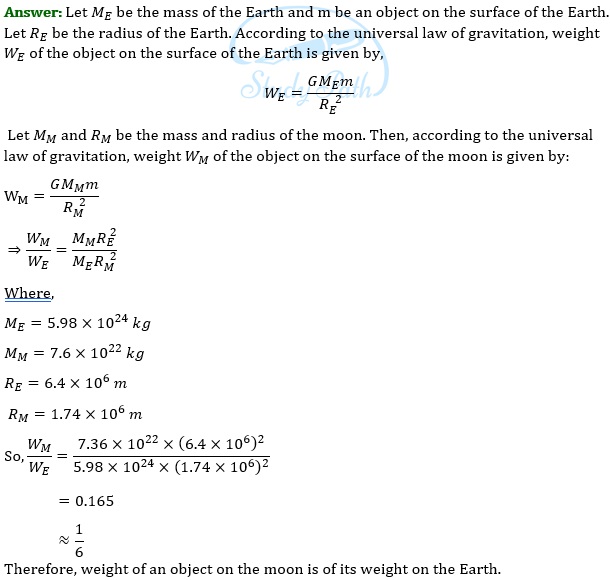
PAGE NO 141
Question 1: Why is it difficult to hold a school bag having a strap made of a thin and strong string?
Answer: It is difficult to hold a school bag having a thin strap because the pressure on the shoulders is quite large. This is because the pressure is inversely proportional to the surface area on which the force acts. The smaller is the surface area; the larger will be the pressure on the surface. In the case of a thin strap, the contact surface area is very small. Hence, the pressure exerted on the shoulder is very large.
Question 2: What do you mean by buoyancy?
Answer: The upward force exerted by a liquid on an object immersed in it is known as buoyancy. When you try to immerse an object in water, then you can feel an upward force exerted on the object, which increases as you push the object deeper into water.
Question 3: Why does an object float or sink when placed on the surface of water?
Answer: An object float or sink when placed on the surface of water because of two reasons.
(i) If its density is greater than that of water, an object sinks in water.
(ii) If its density is less than that of water, an object floats in water.
PAGE NO 142
Question 1: You find your mass to be 42 kg on a weighing machine. Is your mass more or less than 42 kg?
Answer: When you weigh your body, an upward force acts on it. This upward force is the buoyant force. As a result, the body gets pushed slightly upwards, causing the weighing machine to show a reading less than the actual value.
Question 2: You have a bag of cotton and an iron bar, each indicating a mass of 100 kg when measured on a weighing machine. In reality, one is heavier than other. Can you say which one is heavier and why?
Answer: The bag of cotton is heavier than iron bar. This is because the surface area of the cotton bag is larger than the iron bar. Hence, more buoyant force acts on the bag than that on an iron bar. This makes the cotton bag lighter than its actual value. For this reason, the iron bar and the bag of cotton show the same mass on the weighing machine, but actually the mass of the cotton bag is more than that of the iron bar.
Question 1: How does the force of gravitation between two objects change when the distance between them is reduced to half?

Hence, if the distance is reduced to half, then the gravitational force becomes four times larger than the previous value.
Question 2: Gravitational force acts on all objects in proportion to their masses. Why then, a heavy object does not fall faster than a light object?
Answer: All objects fall on ground with constant acceleration, called acceleration due to gravity (in the absence of air resistances). It is constant and does not depend upon the mass of an object. Hence, heavy objects do not fall faster than light objects.
Question 3: What is the magnitude of the gravitational force between the earth and a 1 kg object on its surface? (Mass of the earth is 6 × 10 24 kg and radius of the earth is 6.4 × 10 6 m).
Answer: Given, Mass of Earth, M = 6 × 10 24 kg Mass of object, m = 1 kg Universal gravitational constant, G = 6.7 × 10 −11 Nm 2 kg −2 Radius of the Earth, R = 6.4 × 10 6 m
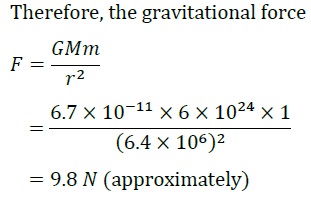
Question 4: The earth and the moon are attracted to each other by gravitational force. Does the earth attract the moon with a force that is greater or smaller or the same as the force with which the moon attracts the earth? Why?
Answer: According to the universal law of gravitation, two objects attract each other with equal force, but in opposite directions. The Earth attracts the moon with an equal force with which the moon attracts the earth.
Question 5: If the moon attracts the earth, why does the earth not move towards the moon?
Answer: The Earth and the moon experience equal gravitational forces from each other. However, the mass of the Earth is much larger than the mass of the moon. Hence, it accelerates at a rate lesser than the acceleration rate of the moon towards the Earth. For this reason, the Earth does not move towards the moon.
Question 6: What happens to the force between two objects, if
(i) the mass of one object is doubled? (ii) the distance between the objects is doubled and tripled? (iii) the masses of both objects are doubled?
Answer: According to the universal law of gravitation, the force of gravitation between two objects is given by:
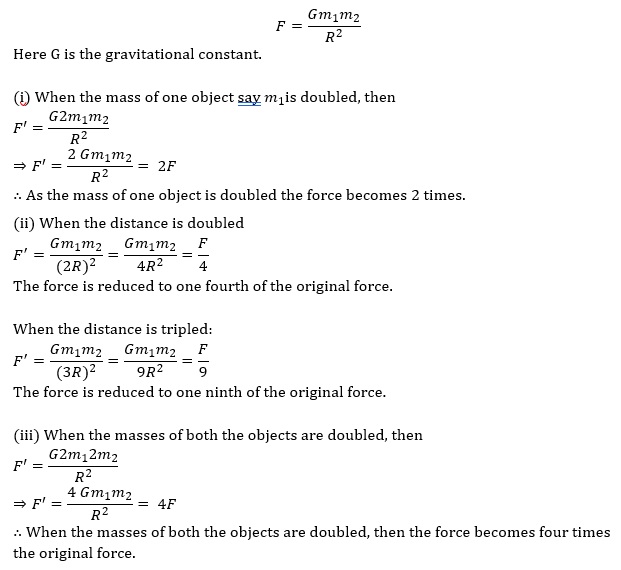
Question 7: What is the importance of universal law of gravitation?
Answer: The universal law of gravitation explains many phenomena that were believed to be unconnected:
(i) The motion of the moon round the earth (ii) The force that binds North American nation to the world (iii) The tides because of the moon and therefore the Sun (iv) The motion of planets round the Sun
Question 8: What is the acceleration of free fall?
Answer: When objects fall towards the Earth under the effect of gravitational force alone, then they are said to be in free fall. Acceleration of free fall is 9.8 ms −2 , which is constant for all objects (irrespective of their masses).
Question 9: What do we call the gravitational force between the Earth and an object?
Answer: Gravitational force between the earth and an object is known as the weight of the object.
Question 10: Amit buys few grams of gold at the poles as per the instruction of one of his friends. He hands over the same when he meets him at the equator. Will the friend agree with the weight of gold bought? If not, why? [Hint: The value of is greater at the poles than at the equator].
Answer: Weight of a body on the Earth is given by W = mg Where, m = Mass of the body g = Acceleration due to gravity
The value of g is greater at poles than at the equator. Therefore, gold at the equator weighs less than at the poles. Hence, Amit’s friend will not agree with the weight of the gold bought.
Question 11: Why will a sheet of paper fall slower than one that is crumpled into a ball?
Answer: Surface area of a Sheet which is crumpled into a ball, is much smaller than the surface area of a plain or flat sheet. Therefore, despite both experience same force of gravity, the plain or flat sheet of paper will have to face more air resistance than the crumpled ball, so it will fall slower than the sheet crumpled into a ball.
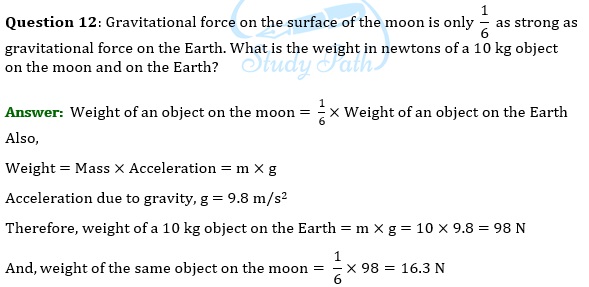
Question 13: A ball is thrown vertically upwards with a velocity of 49 m/s. Calculate: (i) the maximum height to which it rises. (ii) the total time it takes to return to the surface of the earth.
Answer: (i) According to the equation of motion under gravity v 2 − u 2 = 2gs Where, u = Initial velocity of the ball v = Final velocity of the ball s = Height achieved by the ball g = Acceleration due to gravity
At maximum height, final velocity of the ball is zero, i.e., v = 0 m/s and u = 49 m/s
During upward motion, g = − 9.8 m s −2 Max. Height attained by the ball (s) = ?
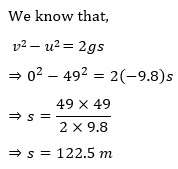
∴ Max. Height attained by the ball (s) = 122.5 m
(ii) Let t be the time taken by the ball to reach the height 122.5 m, then according to the first equation of motion
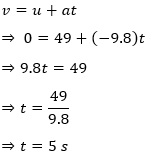
Time for upward journey of the ball will be the same as time for downward journey i.e., t = 5 s.
Therefore, total time taken by the ball to return = 5 + 5 = 10 s
Question 14: A stone is released from the top of a tower of height 19.6 m. Calculate its final velocity just before touching the ground.
Answer: According to the equation of motion under gravity v 2 − u 2 = 2gs Where, u = Initial velocity of the stone = 0 m/s v = Final velocity of the stone s = Height of the stone = 19.6 m g = Acceleration due to gravity = 9.8 ms −2
Now, v 2 = u 2 + 2as ⇒ v 2 − u 2 = 2as ⇒ v 2 − 0 2 = 2 × 9.8 × 19.6 ⇒ v 2 = 2 × 9.8 × 19.6 ⇒ v 2 = 19.6 × 19.6 ⇒ v 2 = (19.6) 2 ⇒ v = 19.6 ms −1
Hence, the velocity of the stone just before touching the ground is 19.6 ms −1 .
Question 15: A stone is thrown vertically upward with an initial velocity of 40 m/s. Taking g = 10 m/s 2 , find the maximum height reached by the stone. What is the net displacement and the total distance covered by the stone?
Answer: Given u = Initial velocity of the stone = 40 m/s v = Final velocity of the stone = 0 m/s s = Height of the stone g = Acceleration due to gravity = −10 ms −2 the maximum height attained by the stone (s) = ?
According to the equation of motion under gravity, v 2 − u 2 = 2gs
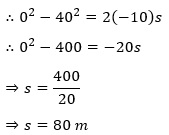
Therefore, total distance covered by the stone during its upward and downward journey = 80 + 80 = 160 m
Net displacement during its upward and downward journey = 80 + (−80) = 0.
Question 16: Calculate the force of gravitation between the earth and the Sun, given that the mass of the earth = 6 × 10 24 kg and of the Sun = 2 × 10 30 kg. The average distance between the two is 1.5 × 10 11 m.
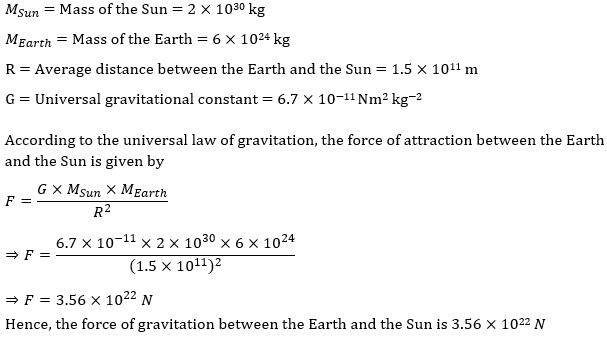
Question 17: A stone is allowed to fall from the top of a tower 100 m high and at the same time another stone is projected vertically upwards from the ground with a velocity of 25 m/s. Calculate when and where the two stones will meet.
Answer: Let the two stones meet after a time t.
When the stone dropped from the tower Initial velocity, u = 0 m/s Let the displacement of the stone in time t from the top of the tower be s. Acceleration due to gravity, g = 9.8 ms −2
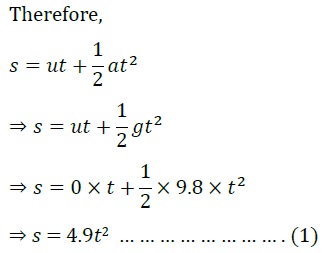
When the stone thrown upwards Initial velocity, u = 25 ms −1 Let the displacement of the stone from the ground in time t be 𝑠′. Acceleration due to gravity, g = −9.8 ms −2
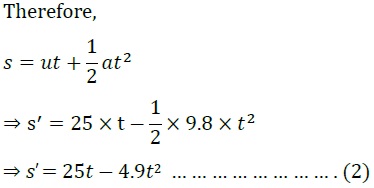
The combined displacement of both the stones at the meeting point is equal to the height of the tower 100 m.
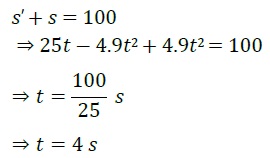
In 4 s, the falling stone has covered a distance given by (1) as 𝑠 = 4.9 × 4 2 = 78.4 𝑚
Therefore, the stones will meet after 4s at a height (100 – 78.4) = 20.6 m from the ground.
Question 18: A ball thrown up vertically returns to the thrower after 6 s. Find
(a) The velocity with which it was thrown up, (b) The maximum height it reaches, and (c) Its position after 4s.
Answer: (a) The velocity with which ball was thrown up : Acceleration due to gravity, g = – 9.8 ms –2 As the total time taken in upward and return journey by the ball is 6 s. Therefore, The upward journey, t = 6/2 s = 3 s Final velocity, v = 0 ms –1 Initial velocity, u = ?
Using equation of motion, v = u + at, we have
0 = u + (−9.8 × 3) ⇒ u = 9.8 × 3 ⇒ u = 29.4 m/s
Hence, the ball was thrown upwards with a velocity of 29.4 m/s.
(b) Let the maximum height attained by the ball be s. Initial velocity during the upward journey, u = 29.4 m/s Final velocity, v = 0 m/s Acceleration due to gravity, g = −9.8 ms −2
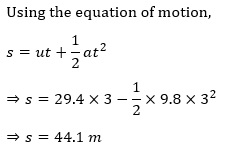
Hence, the maximum height is 44.1 m.
(c) Ball attains the maximum height after 3s. After attaining this height, it will start falling downwards.
In this case,
Initial velocity, u = 0 m/s
Position of the ball after 4 s of the throw is given by the distance travelled by it during its downward journey in 4 s − 3 s = 1 s.
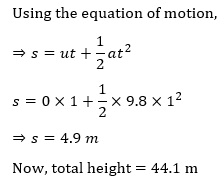
Now, total height = 44.1 m
This means, the ball is 39.2 m (44.1 m − 4.9 m) above the ground after 4 seconds.
Question 19: In what direction does the buoyant force on an object immersed in a liquid act?
Answer: An object immersed in a liquid experiences buoyant force in the upward direction.
Question 20: Why does a block of plastic released under water come up to the surface of water?
Answer: Two forces act on an object immersed in water. One is the gravitational force, which pulls the object downwards, and the other is the buoyant force, which pushes the object upwards. If the upward buoyant force is greater than the downward gravitational force, then the object comes up to the surface of the water as soon as it is released within water. Due to this reason, a block of plastic released under water comes up to the surface of the water.
Question 21: The volume of 50 g of a substance is 20 cm 3 . If the density of water is 1 g cm −3 , will the substance float or sink?
Answer: If the density of an object is more than the density of a liquid, then it sinks in the liquid. On the other hand, if the density of an object is less than the density of a liquid, then it floats on the surface of the liquid.
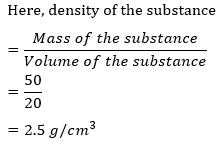
The density of the substance is more than the density of water (1 g cm −3 ). Hence, the substance will sink in water.
Question 22: The volume of a 500 g sealed packet is 350 cm 3 . Will the packet float or sink in water if the density of water is 1 g cm −3 ? What will be the mass of the water displaced by this packet?
Answer: Density of the 500 g sealed packet
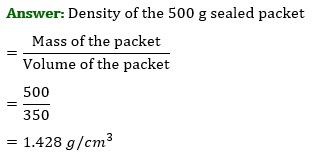
The density of the substance is more than the density of water (1𝑔/𝑐𝑚 3 ). Hence, it will sink in water.
The mass of water displaced by the packet is equal to the volume of the packet, i.e., 350g.
Class 9 Science NCERT Solutions Chapter 10 Gravitation
CBSE Class 9 Science NCERT Solutions Chapter 10 helps students to clear their doubts and to score good marks in the board exam. All the questions are solved by experts with a detailed explanation that will help students complete their assignments & homework. Having a good grasp over CBSE NCERT Solutions for Class 9 Science will further help the students in their preparation for board exams and other competitive exams such as NTSE, Olympiad, etc.
NCERT Solutions for Class 9 Science Chapter 10 PDF
Below we have listed the topics discussed in NCERT Solutions for Class 9 Science Chapter 10. The list gives you a quick look at the different topics and subtopics of this chapter.
| Section in NCERT Book | Topics Discussed |
|---|---|
| 10.1 | Gravitation |
| 10.1.1 | Universal Law of Gravitation |
| 10.2 | Free Fall |
| 10.3 | Mass |
| 10.4 | Weight |
| 10.5 | Thrust and Pressure |
| 10.5.2 | Buoyancy |
| 10.6 | Archimedes’ Principle |
| 10.7 | Relative Density |
Leave a Reply Cancel reply
Your email address will not be published. Required fields are marked *
Save my name, email, and website in this browser for the next time I comment.
Class 10 Science Chapter 5 Case Based Questions - Life Processes
| 1 Crore+ students have signed up on EduRev. Have you? |
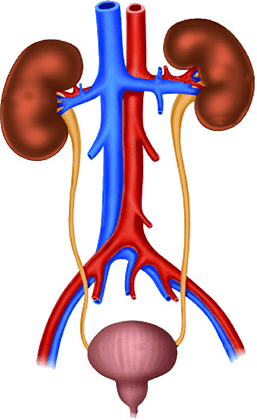
Question 1: Which of these is the structural and functional unit of part 2? (a) Alveoli (b) Nephron (c) Neuron (d) None of these
Correct Answer is Option (b) A nephron is the basic functional unit of kidneys that consists of a glomerulus and its associated tubules through which the glomerular filtrate passes before it emerges as urine. They are the microscopic structure composed of a renal corpuscle and a renal tubule.
Question 2: Choose the correct path of urine in our body: (a) kidney → ureter → urethra → urinary bladder (b) kidney → urinary bladder → urethra → ureter (c) kidney → ureters → urinary bladder → urethra (d) urinary bladder → kidney → ureter → urethra
Correct Answer is Option (c) Kidneys are the paired organs where urine formation takes place. Small muscular tube, called as ureter, extend from kidneys and carries urine to urinary bladder. The urethra is a small tube that extends from the urinary bladder to an external opening.
Read the given passage and answer the questions from. Oxygen-rich blood from the lungs comes to the thin-walled upper chamber of the heart on the left. The left upper chamber (A) then relaxes. It then contracts and the blood is allowed to enter the next chamber (B), as it expands. When the muscular left lower chamber of heart contracts the blood is pumped out to the body via aorta. Deoxygenated blood reaches from the body to the upper chamber on the right side of heart (C) and it expands. As this part contracts, the corresponding lower chamber (D) dilates. This transfers the blood to right ventricle, which in turn pumps it to the lungs for oxygenated. Question 3: Which of these correctly represents the label A, B, C and D in the above passage? (a) A - Left atrium, B- Left Ventricle, C- Right atrium, D- Right ventricle (b) A - Right ventricle, B- Left atrium, C- Left Ventricle, D- Right atrium (c) A- Right atrium, B- Right ventricle, C- Left atrium, D- Left ventricle (d) A- Left ventricle, B- Right atrium, C- Right ventricle, D- Left atrium
Correct Answer is Option (a) A- Left atrium, B- Left Ventricle, C- Right atrium, D- Right ventricle
Question 4: What is the correct route of blood in a human? (a) A → B → Lungs → C → D (b) A → B → D → C → Lungs (c) C → D → B → A → Lungs (d) C → D → Lung → A → B
Correct Answer is Option (d) C (Right atrium) → D (Right ventricle) → Lungs → A (Left atrium) → B (Left ventricle).
Question 5: What prevents backflow of blood inside the heart during contraction? (a) Valves in heart (b) Thick muscular walls of ventricles (c) Thin walls of atria (d) All of the above
Correct Answer is Option (a) False. Valves prevent the back flow of blood inside the heart during contraction of heart chambers (atria or ventricles).
Read the passage and answer the questions. Some experiments were carried out using Croton sp. plants to understand the process of photosynthesis. It was observed that the leaves of the plant exposed to light for longer duration accumulated more starch. However, due to presence of pre-formed starch in the leaves, it was difficult to find the net productivity on a fixed exposure to light source. Therefore, it was necessary to obtain starch free leaves in the plant before starting the experiment. Question 6: Which of the following would help obtain starch free leaves in the plant? (a) Expose the leaves to blue light for 48 hours before starting the experiment. (b) Keep the plant in dark for about 48 hours before starting the experiment. (c) Remove starch from the leaves by exosmosis, 48 hours before starting the experiment. (d) Keep the leaves to red light for 48 hours before starting the experiment.
Correct Answer is Option (b) The starch free leaves can be obtained by keeping the plant in dark, so that already present starch is utilized in 48 hrs.
Question 7: After a period of illumination, the leaves were boiled in alcohol to make them colourless. Which of the following could be used to test the end product stored in the leaves? (a) Cobalt chloride paper (b) Litmus paper (c) Iodine solution (d) Copper sulphate solution
Correct Answer is Option (c) Starch presence can be tested by adding iodine solution which gives bluish black colour of starch – iodine mixture.
Question 8: Some of the starch free leaves were coated with wax on both the surfaces. The plant was maintained under normal environmental conditions. At the end of the experiment, the wax coated leaves are likely to show _____. (a) Accumulation of more water. (b) Wilting of the wax coated leaves. (c) Increase in sucrose accumulation. (d) Decrease in number of chloroplasts
Correct Answer is Option (b) Wilting occurs due to wax blocks the transpiration so water transportation inhibits.
Question 9: During the morning hours, using a fine blade, an incision was made to the leaves such that the phloem tissue was cut open. Analysis of the liquid oozing out was found to contain high amount of: (a) Xylose (b) Ribose (c) Sucrose (d) Galactose
Correct Answer is Option (c) The transport of glucose, occurs in the form of sucrose, in phloem therefore, when cell sap oozes out, liquid contains sucrose.
Top Courses for Class 10
FAQs on Class 10 Science Chapter 5 Case Based Questions - Life Processes
| 1. What are the different life processes? |
| 2. What is the process of nutrition? |
| 3. How does respiration occur in living organisms? |
| 4. What is transportation in living organisms? |
| 5. Why is excretion important in living organisms? |
| Rating | |
| Last updated |
Extra Questions
Semester notes, practice quizzes, sample paper, previous year questions with solutions, important questions, past year papers, study material, viva questions, mock tests for examination, video lectures, shortcuts and tricks, objective type questions.

Case Based Type Practice Questions: Life Processes Free PDF Download
Importance of case based type practice questions: life processes, case based type practice questions: life processes notes, case based type practice questions: life processes class 10, study case based type practice questions: life processes on the app.
| cation olution |
| Join the 10M+ students on EduRev |
Welcome Back
Create your account for free.

Forgot Password
Unattempted tests, change country, practice & revise.

IMAGES
COMMENTS
In CBSE Class 10 Science Paper, Students will have to answer some questions based on Assertion and Reason. There will be a few questions based on case studies and passage based as well. In that, a paragraph will be given, and then the MCQ questions based on it will be asked. Here, we have provided … Continue reading Case Study and Passage Based Questions for Class 10 Science Chapter 9 ...
Please refer to Chapter 9 Heredity And Evolution Case Study Questions with answers provided below. We have provided Case Study Questions for Class 10 Science for all chapters as per CBSE, NCERT and KVS examination guidelines. These case based questions are expected to come in your exams this year.
Download Case study questions for CBSE class 10 Science in PDF format from myCBSEguide App. We have new pattern paragraph type case study based questions for free download.
Here we are providing you with Class 10 Science Chapter 9 Heredity and Evolution Case Study Questions, by practicing these Case Study and Passage Based Questions will help you in your Class 10th Board Exam.
Get CBSE Class 10 Science Chapter Wise Important Case Study Questions with Solution here to prepare for CBSE Class 120 Science board exam 2024.
To support your preparation for Class 10 Science examinations, we have created a comprehensive PDF resource containing a collection of case study questions designed specifically for this subject. This PDF includes a variety of case studies covering different topics in Physics, Chemistry, and Biology. It will provide you with ample practice ...
Case Study Questions Class 10 Science. In board exams, students will find the questions based on assertion and reasoning. Also, there will be a few questions based on case studies. In that, a paragraph will be given, and then the MCQ questions based on it will be asked. Case Study Questions for Chapter 1 Chemical Reactions and Equations.
This Article Contains Science Chapter-Wise Multiple Case Study Worksheets With Explanations For Class 10th Board Exams. CBSE has recently included these type of MCQ questions and one thing that is certain about these type of questions Is that once students practices how to solve these questions, You will never get an answer wrong that is for certain.
Case Study Question and Answers for Class 10 Science all Chapter 1 to 16. Case Based Factual Passage Question & Answer.
Also working on NCERT Solutions For Class 10 Science Chapter 9 will give you a strong foundation on the competitive exams like JEE, NEET, UPSC, etc., Read on to find out everything about NCERT Solutions For Class 10 Science Chapter 9 Heredity and Evolution.
The Class 10 NCERT Solutions for Science Chapter 9 Heredity and Evolution includes all the intext and exercise questions. Class 10 Science Chapter 9 Heredity and Evolution NCERT questions and answers help students to clear their doubts and to obtain good marks in Class 10 board exam. All the solutions provided in this article are strictly based ...
NCERT Solutions for class-10 Science chapter-9 Heredity and Evolution is prepared by our Physics Wallah team.
Case Study/Passage-Based Questions. Case Study 1: According to the universal law of gravitation, the force between two particles or bodies is directly proportional to the product of their masses and inversely proportional to the square of the distance between these particles or bodies. Consider two bodies A and B having masses m 1 and m 2 ...
Hope the information shed above regarding Case Study and Passage Based Questions for Class 9 Science Chapter 9 Force and Laws of Motion with Answers Pdf free download has been useful to an extent.
In CBSE Class 10 Science Paper, Students will have to answer some questions based on Assertion and Reason. There will be a few questions based on case studies and passage based as well. In that, a paragraph will be given, and then the MCQ questions based on it will be asked. Here, we have provided case … Continue reading Case Study and Passage Based Questions for Class 10 Science Chapter 10 ...
Hello students, we are providing case study questions for class 9 science. Case study questions are the new question format that is introduced in CBSE board.
If you are wondering how to solve class 9 science case study questions, then myCBSEguide is the best platform to choose. With the help of our well-trained and experienced faculty, we provide solved examples and detailed explanations for the recently added Class 9 Science case study questions.
CBSE Class 10 Science Case Study, Assertion & Reasoning, MCQ The Class tenth CBSE Science Case Study, Assertion & Reasoning, MCQs are very helpful in practicing and getting a deep understanding in the topics of science. However, a comprehensible knowledge of NCERT Science Book is a must to be able to solve these types of problems.
Download PDF Case Study Questions of Class 9 Science to prepare for the upcoming CBSE Class 9 Exams Exam 2023-24. With the help of our well-trained and experienced faculty, we provide solved examples and detailed explanations for the recently added Class 9 Science case study questions.
CBSE Class 10th - SCIENCE : Chapterwise Case Study Question & Solution In board exams, students will find the questions based on assertion and reasoning. Also, there will be a few questions based on case studies. In that, a paragraph will be given, and then the MCQ questions based on it will be asked. For Science subjects, there would be 5 case-based sub-parts questions, wherein a student has ...
This article aims to present a comprehensive collection of case study questions for Class 9 Science, covering various topics and concepts. Join our Telegram Channel, there you will get various e-books for CBSE 2024 Boards exams for Class 9th, 10th, 11th, and 12th. CBSE Class 9 Science Exam will have a set of questions based on case studies in ...
In these solutions, we have answered all the intext and exercise questions provided in NCERT class 9 science textbook. Class 9 NCERT Solutions Science Chapter 10 provided in this article are strictly based on the CBSE syllabus and curriculum. Students can easily download these solutions in PDF format for free from our app.
The Case Based Type Practice Questions: Life Processes is an invaluable resource that delves deep into the core of the Class 10 exam. These study notes are curated by experts and cover all the essential topics and concepts, making your preparation more efficient and effective.
Case Study Questions for Class 9 Science Chapter 10 Gravitation In CBSE Class 9 Science Paper, Students will have to answer some questions based on Assertion and Reason. There will be a few questions based on case studies and passage based as well. In that, a paragraph will be given, and then questions based on it will be … Continue reading Case Study and Passage Based Questions for Class 9 ...